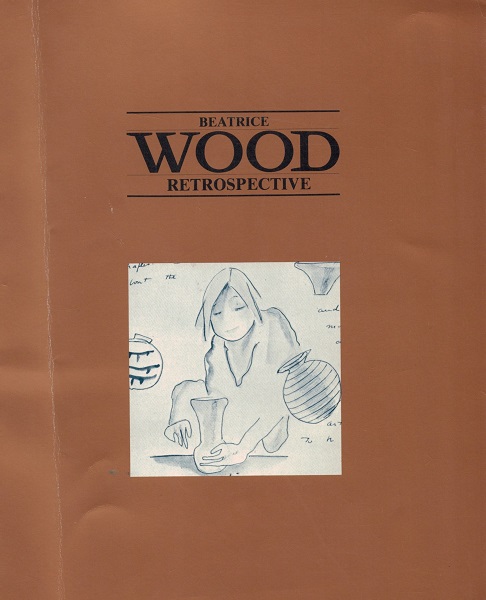Chess Notes
Edward Winter
When contacting us by e-mail, correspondents are asked to include their name and full postal address and, when providing information, to quote exact book and magazine sources. The word ‘chess’ needs to appear in the subject-line or in the message itself.
| First column | << previous | Archives [150] | next >> | Current column |
10276. Material considerations
From Max Euwe’s ‘Game of the Month’ column on pages 74-75 of Chess Review, March 1952:
‘Masters of the future may differ from the older ones in paying less attention to material advantages. In this connection, Sämisch has made one of the most telling comments I have ever encountered on the subject: he remarks that he finds it easier to sacrifice in a blindfold game than in a regular game – because in a blindfold game he finds it easier to ignore purely material considerations.’
10277. Pistyan, 1922
Jan Kalendovský (Brno, Czech Republic) has found these photographs at the Moravská zemská knihovna website:

Světozor, 11 May 1922, page 406
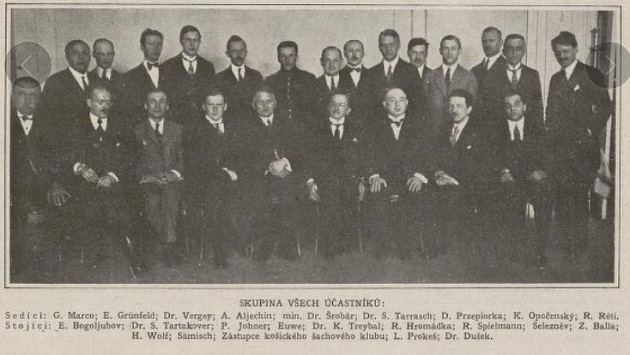
Světozor, 25 May 1922, page 428
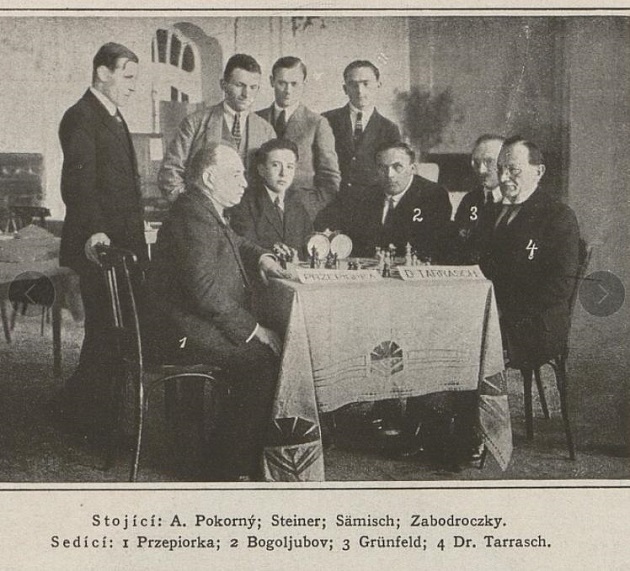
Světozor, 25 May 1922, page 429
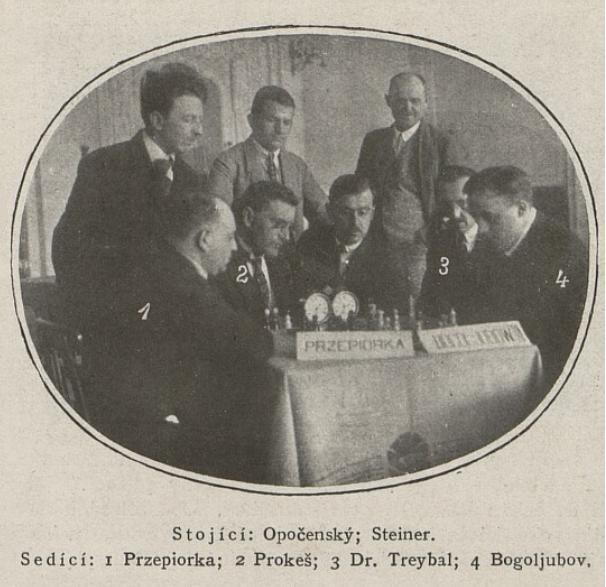
Světozor, 25 May 1922, page 429.
10278. Picture-tampering (C.N.s 3757, 3901, 10147 & 10210)
Even contemporary Russian books offer grisly examples. From page 367 of Короли шахматного мира by V.I. and I.M. Linder (Moscow, 2001):
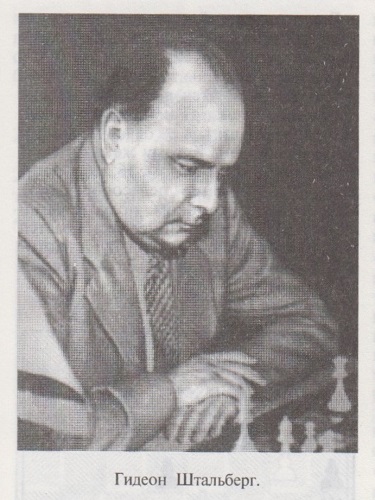
As shown in Pet Moves in Chess (see too the plate section of Chess Explorations), our archives include this portrait of Ståhlberg:
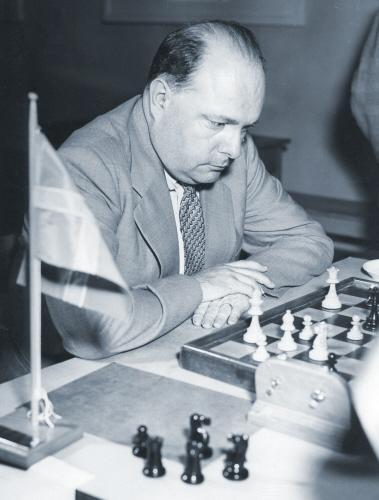
10279. Grandmasters
The 1952 article by Euwe mentioned in C.N. 10276 began with this observation:
‘The USSR Championship usually enlists the efforts of almost half the holders of the title of Grand Master in the FIDE.’
From page 296 of CHESS, June 1968:
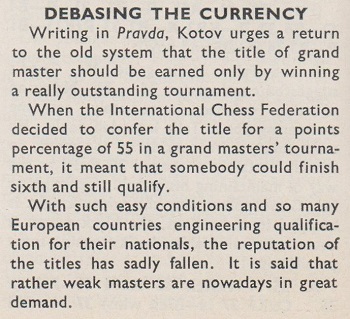
Such additional jottings on the subject of Chess Grandmasters are always welcome.
10280. Capablanca
From page 137 of The Sketch, 6 May 1914:
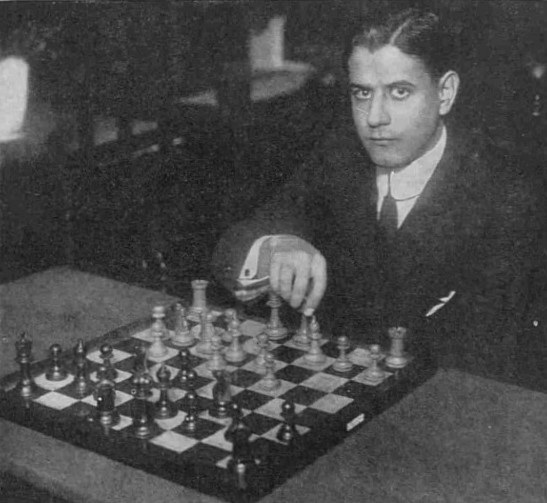
The photograph also appeared on page 35 of the Cuban magazine Bohemia, 15 March 1942:
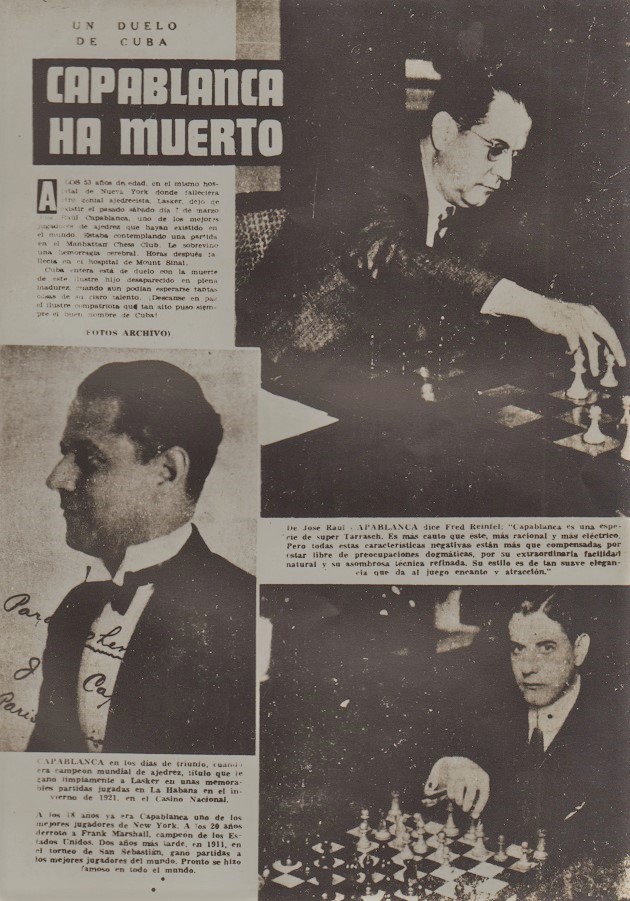
10281. Reinfeld on Capablanca (C.N.s 473 & 5036)
Page 51 of Great Moments in Chess by Fred Reinfeld (New York, 1963) stated that Capablanca ‘went on to defeat Frank Marshall in a match by 9-1, a score not too far from Lasker’s world championship match victory over Marshall two years earlier by 7-0’.
Both scores are wrong.
10282. Puzzle (C.N. 10245)
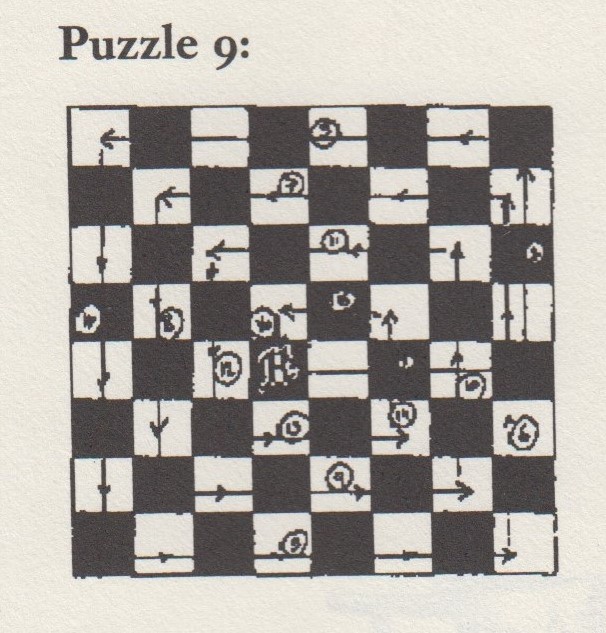
On page 239 of Murder at the Chessboard edited by ‘P.T. Houdunitz’ (New York, 2001) the above was the (full) solution to a puzzle set on page 166.
Having placed a rook on one of the four centre squares of the board, Sherlock Holmes asked Dr Watson:
‘What is the minimum number of moves this rook needs to make in order to pass over all the squares on the board and then return to its original square?’
10283. Rune Litzberger
A news feature on page 135 of Chess Review, May 1952:
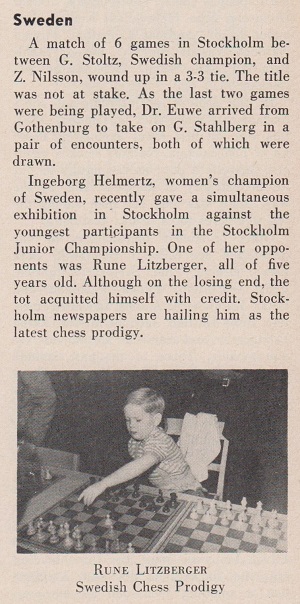
An article (‘Svensk Capablanca!’) with another photograph of Rune Litzberger had been published on page 16 of Tidskrift för Schack, January 1952. Occasional later references to him (with the spelling Litsberger) are readily found, but is a comprehensive biographical note available?
10284. Bobby Fischer’s Games of Chess
C.N. 8226 (see too Fischer’s Fury) noted the absence of any mention of My 60 Memorable Games in Chess Review throughout the year in which the book was published (1969). Nor, as far as we can see, did Chess Review refer to Bobby Fischer’s Games of Chess when it appeared (in 1959).
That earlier book was listed on page 6 of Chess Life, 5 June 1959:
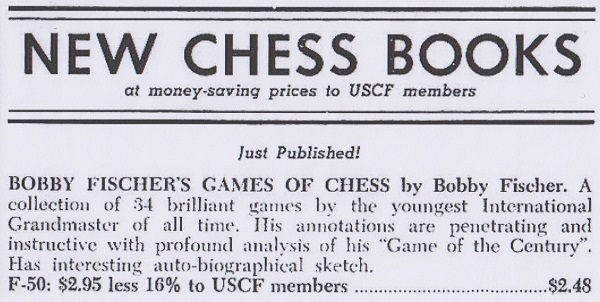
In reality, most of the games were bare scores, and the 97-page volume was not widely praised. Pages 80-81 of the March 1960 BCM had a brief critique of ...
‘... this topical but otherwise disappointing book. The whole contents could have been given comfortably in half the number of pages at a considerably lower price.’
The UK edition sold at 12s. 6d. and had a two-page
Foreword by Harry Golombek. (He was the Games and Overseas
News Editor of the BCM, but under the editorship
of Brian Reilly the magazine was not the place for
cronyism; see, for instance, C.N. 3551.)
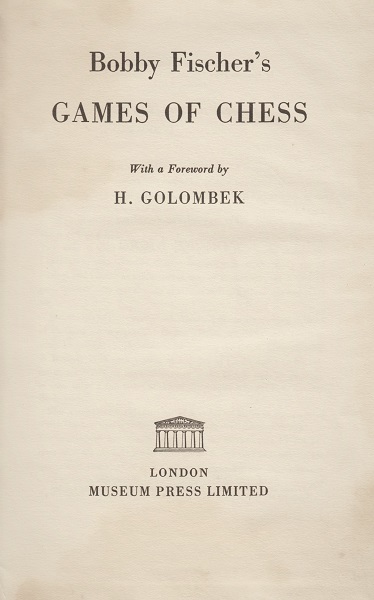
Bobby Fischer’s Games of Chess received a surprisingly warm welcome on page 19 of the January 1960 Chess World, where C.J.S. Purdy remarked:
‘We call the book expensive because it is not much more than a book of Fischer’s games in the USA championship of 1957-58. Perhaps it is not expensive if you consider the miracle of a boy of 14 winning the championship of one of the world’s strongest nations and ahead of the player then regarded as the strongest of the Western world – a standing Fischer himself has now usurped – and not only winning it but capably annotating his games in a mature and objective style.’
Whatever the merits of the book, the publicity for it was delusive. Michael Clapham (Ipswich, England) has sent us an advertisement which appeared in six consecutive editions of the Chess Review catalogue (1960-65):

The games against Tal, Petrosian, Gligorić, Bronstein and 16 others (i.e. the full set played at the 1958 Interzonal tournament in Portorož) were unannotated.
10285. Early Keres
Page 153 of The Bright Side of Chess by Irving Chernev (Philadelphia, 1948) provided a reminder of the outstanding status of Paul Keres in his youth:

The list of victims of Keres’ brilliancies is illogical, given that Reinfeld’s cut-off point was the age of 20. His remark, which had an additional reference to Alekhine, was on page 1 of Keres’ Best Games of Chess 1931-1940 (London, 1941):
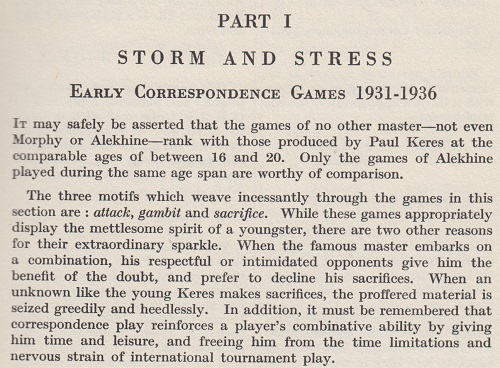
10286. Pillsbury v Newman (C.N. 10272)
The possibility of 17 Qf3 was also pointed out on page 242 of the August 1900 Deutsche Schachzeitung (edited by Berger and Schlechter):

10287. Hoffer and Mason
From an unsigned article about London, 1899 on pages 9-10 of the July 1899 American Chess Magazine:
‘Mason has in him a talent for the game that in any other man would have made a champion.’
The remark brings to mind page 56 of The Knights and Kings of Chess by G.A. MacDonnell (London, 1894), in the chapter on Mason:
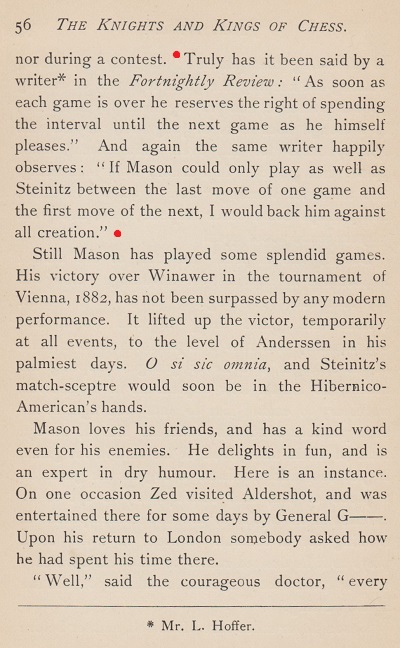
Some passages by later writers:
- ‘As Hoffer observed: “If Mason could only play as well as Steinitz between the last move of one game and the first move of the next, I would back him against all creation.”’
G.H. Diggle, Newsflash, April 1980; see too page 56 of Chess Characters (Geneva, 1984);
- ‘Hoffer observed, “If Mason could only play as well as Steinitz between the last move of one game and the first move of the next, I would back him against all creation”.’
K. Landsberger on page 239 of William Steinitz, Chess Champion (Jefferson, 1993);
- ‘But, as Hoffer put it, “If Mason could only play as well as Steinitz between the last move of one game and the first move of the next, I would back him against all creation”.’
A. Soltis on page 33 of Frank Marshall, United States Chess Champion (Jefferson, 1994).
We note, firstly, that in his obituary of Mason in The Field, 21 January 1905, Hoffer did not claim to have made the remark:
‘It was aptly said of him: “If Mason could only play chess as well as Steinitz between the last move of one game and the first move of the next, I would back him against all creation.” We leave the aphorism as it stands.’
Moreover, on page 765 of the Fortnightly Review, December 1886 Hoffer not only attributed the comment to an unidentified third party but also slightly distanced himself from it:
‘As a friend of mine once observed, “If Mason could only play chess as well as Steinitz between the last move of one game and the first move of the next, I would back him against all creation”. I do not say that I altogether endorse that opinion, but it goes to explain Mason’s failure to take the place in the chess world to which his great abilities entitle him.’
Hoffer quoted that passage in a feature about Mason on page 66 of the Chess Monthly, November 1888.
His 13-page article in the Fortnightly Review proved highly controversial, and we present it in full, together with some of the reaction, in The Chess Masters of To-day by Leopold Hoffer.
10288. Menchik v Mandleberg
From J.H. Mandleberg’s score-book which we own (see C.N. 4039 for his draw against Capablanca), below is a game dated November 1936. Further information is sought.
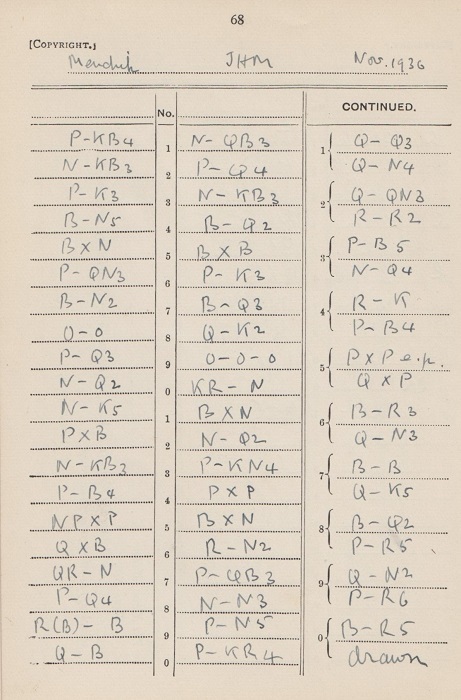
1 f4 Nc6 2 Nf3 d5 3 e3 Nf6 4 Bb5 Bd7 5 Bxc6 Bxc6 6 b3 e6 7 Bb2 Bd6 8 O-O Qe7 9 d3 O-O-O 10 Nbd2 Rhg8 11 Ne5 Bxe5 12 fxe5 Nd7 13 Nf3
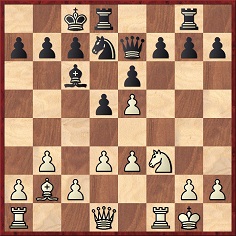
13...g5 14 c4 dxc4 15 bxc4 Bxf3 16 Qxf3 Rg7 17 Rab1 c6 18 d4 Nb6 19 Rfc1 g4 20 Qf1 h5 21 Qd3 Qg5 22 Qb3 Rh7 23 c5 Nd5 24 Re1 f5 25 exf6 Qxf6 26 Ba3 Qg6 27 Bc1 Qe4 28 Bd2 h4 29 Qb2 h3 30 Ba5 Drawn.
10289. Botvinnik in Hastings

This item is from page 76 of The Chess Player’s
Bedside Book by Raymond Bott and Stanley Morrison
(London, 1966). Botvinnik’s first appearance at Hastings
(and, indeed, in any overseas tournament) was in
December/January 1934-35.
From page 45 of the February 1936 BCM, in a report on Hastings, 1935-36:
‘Botvinnik, the Russian champion, who failed to come off at his 1934 appearance, was obliged this year to refuse, as his post-graduate studies did not permit him to play tournament chess more than once a year. In a cordial reply, however, he alluded to the enjoyment of his stay in “beautiful Hastings”, and hoped that a further opportunity would some time be offered him to improve on his first performance.’
10290. Antonín Kvíčala v N.N. (C.N.s 2924 & 6385)
1 e4 c5 2 Bc4 Nc6 3 Nf3 e6 4 Nc3 a6 5 d4 b5 6 d5 bxc4 7 dxc6 d6 8 e5 d5 9 Bg5 f6 10 exf6 Nxf6 11 Ne5 h6 12 c7 Qxc7 13 Bxf6 gxf6 14 Qh5+ Ke7 15 Qf7+ Kd6 16 Qxf6 Bg7
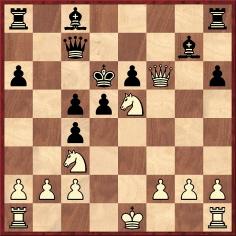
17 Ne4+ dxe4 18 O-O-O mate.
This game was given in C.N. 2924 (see page 43 of Chess Facts and Fables), and C.N. 6385 corrected Black’s 16th move from ...Be7 to ...Bg7. Our source was page 123 of Příruční kniha šachovní by K.B. Kober (Prague, 1875), and C.N. 6385 noted that the heading stated only that the game was played in the Sokol Café (in Prague) on 16 April; no year was specified, but neighbouring games suggested sometime between 1866 and 1874.
Now, Vitaliy Yurchenko (Uhta, Komi, Russian Federation) has provided the exact year, 1869. The game was published on page 280 of Světozor, 20 August 1869, and in the heading the abbreviation t. r. means tohoto roku (i.e. of this year):
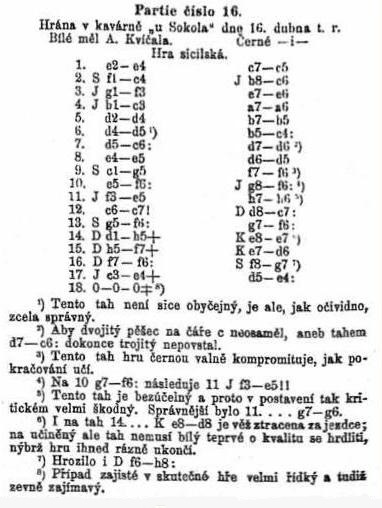
10291. The Sphere
Olimpiu G. Urcan (Singapore) has found dozens of rare pictures in The Sphere, 1910-47. They include the following, which was discussed in C.N. 203 (see pages 139-140 of Chess Explorations and Chess Score-Sheets):
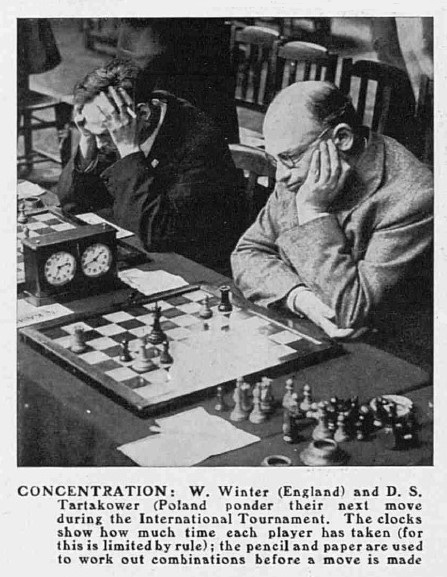
The illustrations discovered by Mr Urcan are presented in our latest feature article, Chess Pictures in The Sphere.
10292. Lajos Steiner
Further to Fred Reinfeld’s description of Eliskases v L. Steiner, Budapest, 1933 as ‘one of the finest games ever played’ (see page 156 of Kings, Commoners and Knaves), we add that, also on page 9 of the January 1952 Chess Review, Reinfeld made these remarks:
‘Lajos Steiner is one of the players who has not received his due from the public. At his best, Steiner is one of the great attacking players of all time. In his finest games, we observe a blend of energy and combinative power which is enchanting. Like many masters in the same category, Steiner is inferior to the very great players because of temperamental defects rather than skill. He is often unstable; he puts forth his best efforts against the stronger players. His opening repertoire, though founded on profound study, is too old-fashioned. He is too good-natured for protracted competition. He tires more easily than most players. He is often baffled when conducting the black pieces, for the initiative is his forte.
Yet Steiner is a great student, with an uncommonly fine understanding of the game, interested above all in producing beautiful chess.’
10293. Staunton’s ‘devilish bad games’
C.N. 2885 (see pages 259-260 of Chess Facts and Fables) included a passage from pages 7-9 of Paul Morphy. His Later Life by C.A. Buck (Newport, 1902):
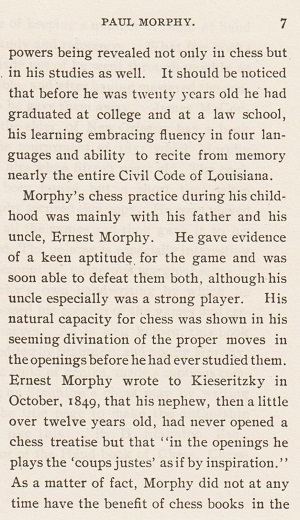

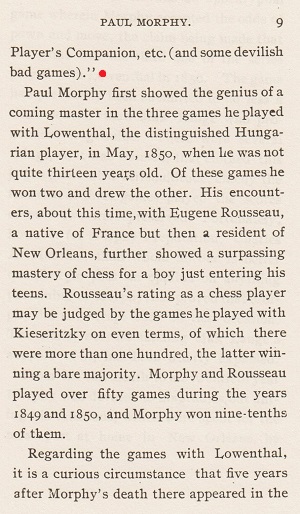
Buck’s text on Morphy had been published on pages 1-7 of the American Chess World, January 1901, introduced as follows:
‘We reprint from the Evening Gazette of Cedar Rapids, Iowa, a biographical sketch of the life of the immortal Morphy, by Mr C.A. Buck, of Toronto, Kansas, who is one of the most enthusiastic and best known chess experts in the Middle West.’
On page 214 of his 1976 biography of Morphy, David Lawson gave 29 December 1900 as the date of the article’s appearance in the Evening Gazette. Can any reader provide a copy?
10294. Letters in Lawson’s book on Morphy
In the late 1980s Frank Skoff sent us a ‘list of letters (plus some other items)’ in David Lawson’s book on Morphy:
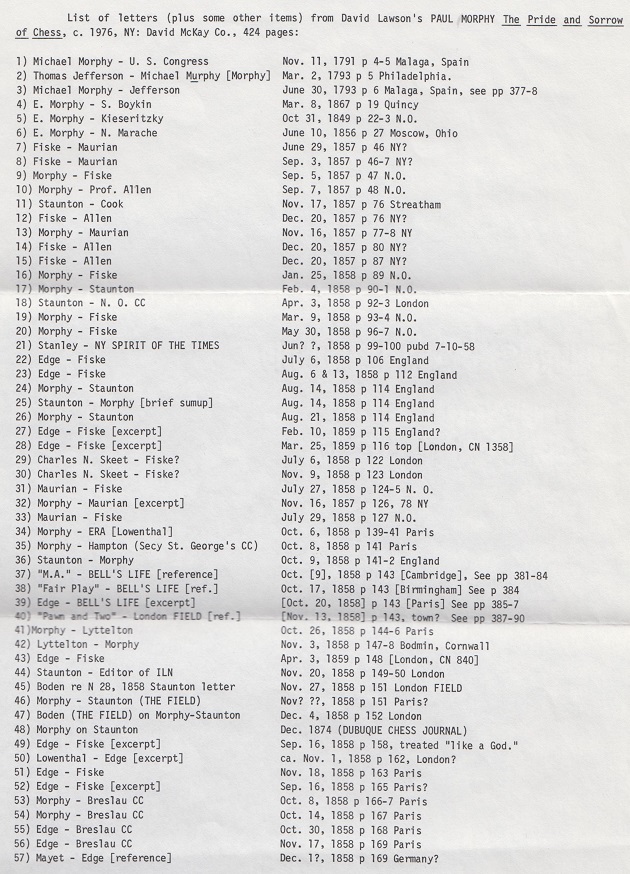

10295. Botvinnik in Hastings (C.N. 10289)
Paul Dorion (Montreal, Canada) notes a comment by Botvinnik on page 116 of his book One Hundred Selected Games (London, 1951):
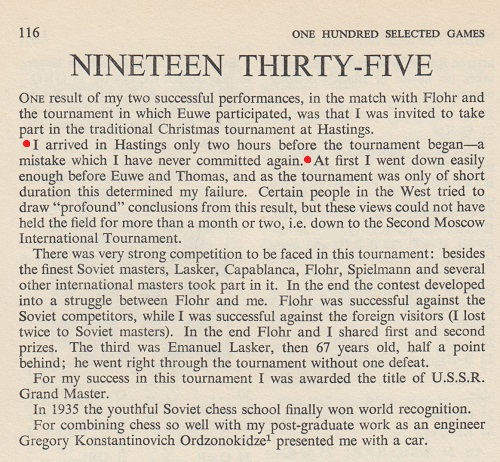
The Russian original, on page 126 of Избранные партии 1926-1946 (Moscow, 1951):
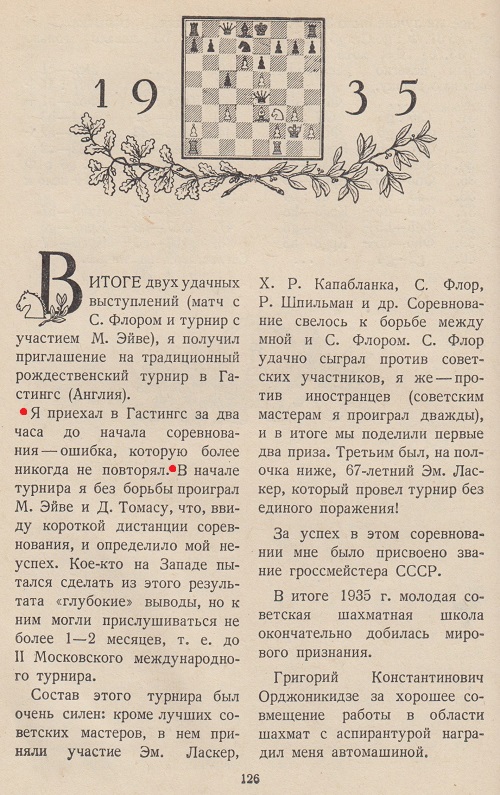
10296. Capablanca v Ribera
Stéphane Pilawski (Hannut, Belgium) asks about a simultaneous game with clocks, Capablanca v Ribera, Barcelona, 1935, on pages 97-98 of The Unknown Capablanca by David Hooper and Dale Brandreth (London, 1975):
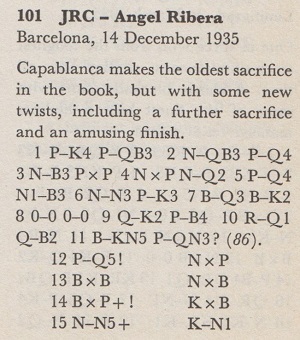
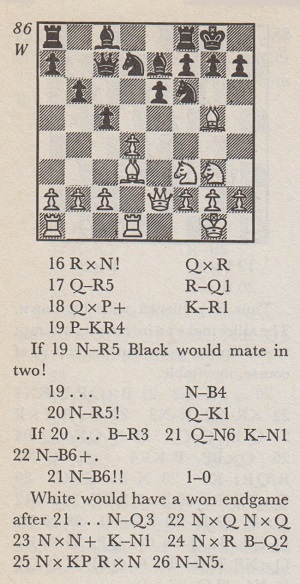
Concerning the position below, our correspondent asks on what grounds it is stated that Black played 19...Nf5:
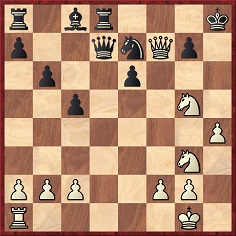
Firstly, we point out that the source (El Ajedrez Español) specified on page 200 of The Unknown Capablanca did not have 19...Nf5. As shown on pages 257-258 of our book on Capablanca, the Cuban annotated his win (‘de lo que recuerdo’) in an article on pages 3-6 of El Ajedrez Español and gave Black’s 19th move as ...Qe8:
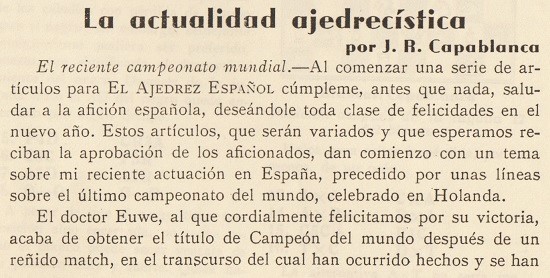
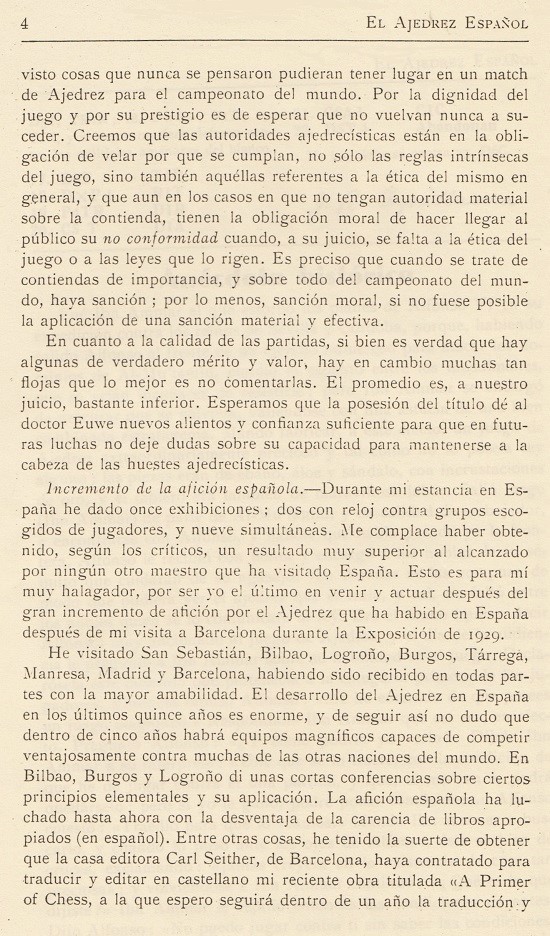
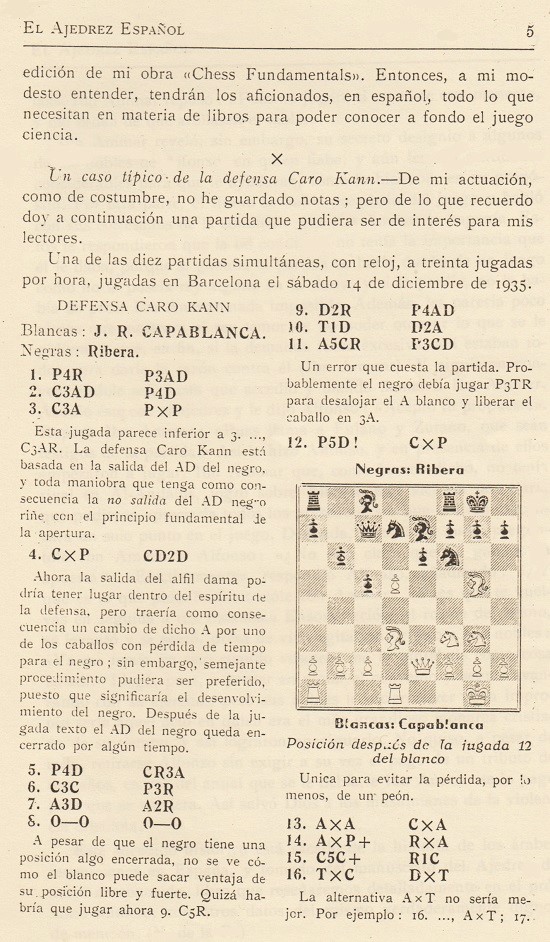
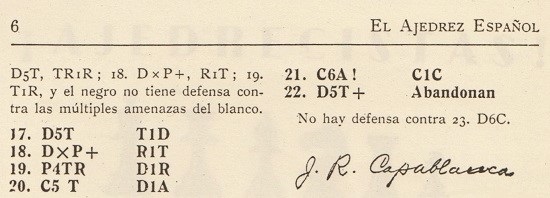
That version of the score (with 19...Qe8, and not 19...Nf5) was published, with a translation of Capablanca’s notes, on page 92 of the April 1936 Chess Review and has appeared in a number of popular works, e.g. on pages 225-226 of The Fireside Book of Chess by I. Chernev and F. Reinfeld (New York, 1949) and on pages 234-235 of Chernev’s Combinations The Heart of Chess (New York, 1960). However, on pages 416-417 of 1000 Best Short Games of Chess (New York, 1955) Chernev gave the 19...Nf5 version.
An early appearance of the game with 19...Nf5 was on pages 104-105 of Deutsche Schachblätter, 1 April 1936:
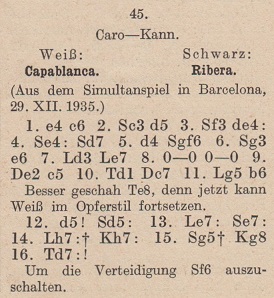

It will be noted that the game was dated 29, and not 14, December 1935 in the German magazine.
Finally, here is Raymond Keene’s contribution on this famous game, in an article about Kasparov and Karpov on page 28 of CHESS, July 1988:

10297. Tal in Stuttgart, 1958 (C.N. 4266)
Dan Scoones (Port Coquitlam, Canada) sends page 12 of the inaugural issue (1/1959) of Tal’s magazine Šahs:
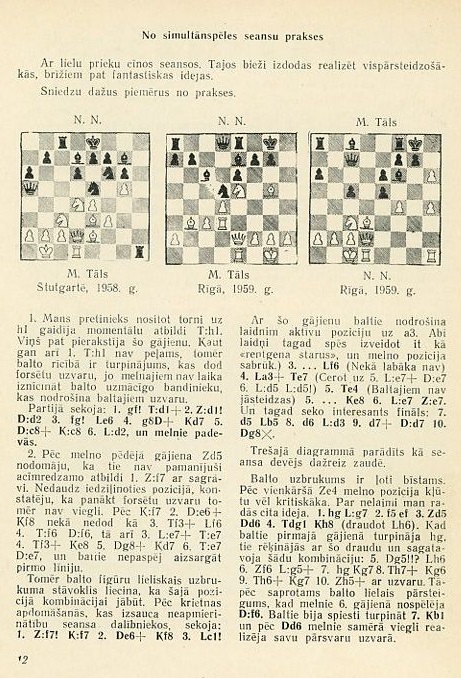
10298. Secret chess contests
Reshevsky is already mentioned in Secret Chess Contests, and below is another small example, from the article ‘Some Chess Memories’ by Constantine Rasis on pages 105-106 of Chess Life, April 1963 (C.N. 10188). The Western Chess Association tournament was held in Detroit from 23 August to 2 September 1924.
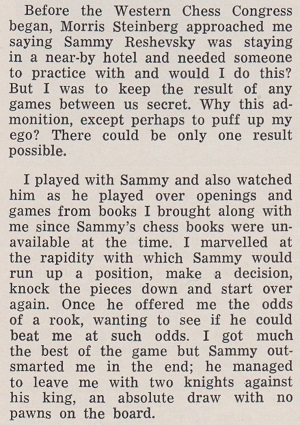
10299. Vlastimil Hort
A reminder of Vlastimil Hort’s standing and reputation early in his career comes from page 221 of CHESS, Easter 1970:

From our collection:
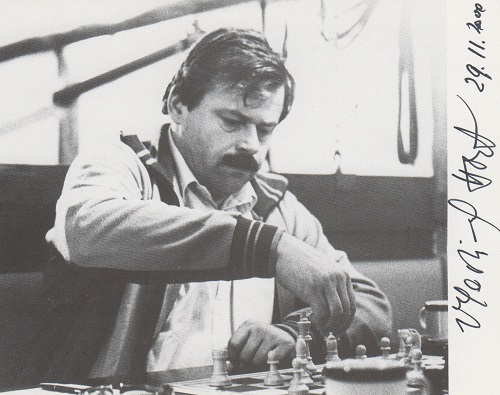
10300. Bernstein v Maróczy, Ostend, 1906
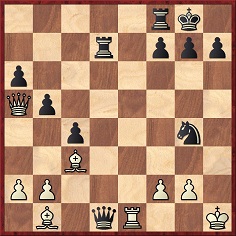
White to move
From page 10 of Chess Review, January 1952 in an article by Tartakower entitled ‘From My Chess Memoirs’:

The episode was also referred to by Albéric O’Kelly de Galway on page 266 of the September 1956 Chess Review:
‘Bernstein narrates the following concerning his game against Maróczy. In a desperate position and about to resign, he saw that his opponent had only 30 seconds for three moves to the time-limit, while he himself had half an hour. Knowing a normal move must lose quickly, he suddenly made a move which was rather stupid. As he expected, his opponent was caught by surprise, flushed nervously, overlooked the winning move and lost.’
The Bernstein v Maróczy game: 1 d4 d5 2 c4 e6 3 Nc3 Nf6 4 Nf3 Be7 5 Bf4 O-O 6 e3 b6 7 cxd5 exd5 8 Bd3 a6 9 O-O Bb7 10 Ne5 c5 11 Qf3 Ra7 12 Rad1 c4 13 Bb1 b5 14 e4 dxe4 15 Nxe4 Nbd7 16 Nc6 Bxc6 17 Nxf6+ Nxf6 18 Qxc6 Qd5 19 Qb6 Rd7 20 Rfe1 Bb4 21 Bd2 Bd6 22 Qa5 Qxd4 23 Bc3 Bxh2+ 24 Kxh2 Ng4+ 25 Kh1 Qxd1

26 f3 Qd5 27 fxg4 Rd6 28 Qc7 b4 29 Be4 Rh6+ 30 Kg1 Qb5 31 Bd2 Re6 32 Bf3 Rfe8 33 Rxe6 Resigns.
The game was annotated on pages 69-71 of Moderne Schachstrategie (Breslau, 1930), a monograph on Bernstein by Tartakower.

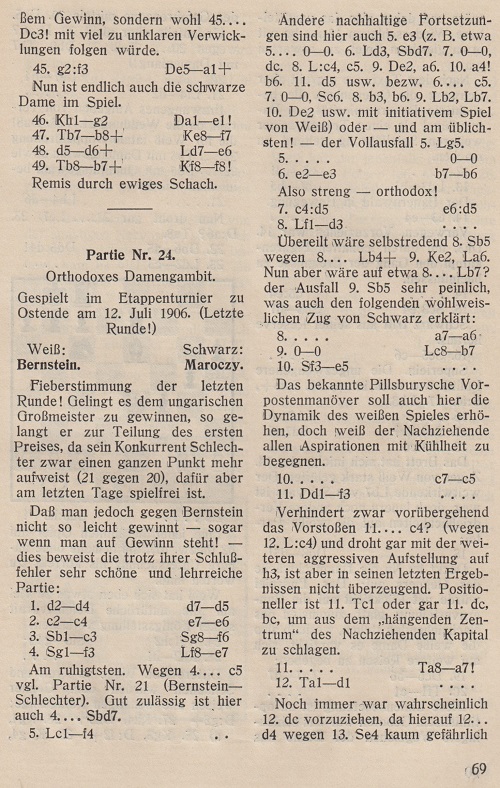
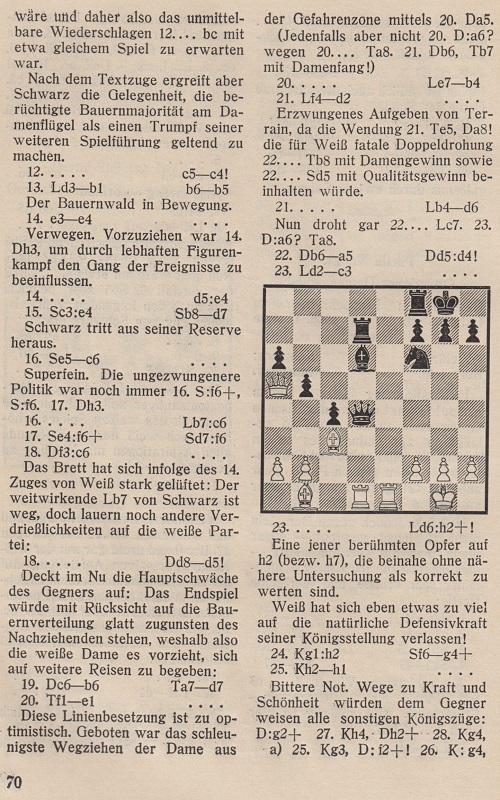
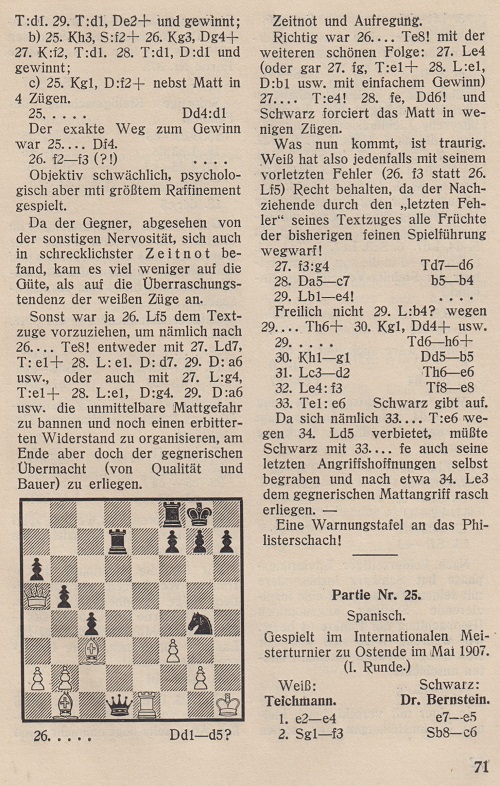
Other notes can be found on pages 395-400 of the Caissa
Editions book on Ostend, 1906 edited by A.J. Gillam
(Yorklyn, 2005), and a computer-check of the game will be
found particularly valuable. A curiosity is that on page
177 of the June 1952 BCM E.G.R. Cordingley stated
that the game was drawn.
10301. A novel prize
On the subject of announced mates:
‘A novel prize is offered by a member of the Manhattan Chess Club to the competitors in the club championship tourney. The prize is to be awarded “for the best long-distance mate or, in other words, to that player who shall announce mate the furthest number of moves ahead”.’
Source: Lasker’s Chess Magazine, December 1904, page 59.
10302. The Graphic
Chess photographs in The Graphic found by Olimpiu G. Urcan (Singapore) are shown below, with a few background notes by us:
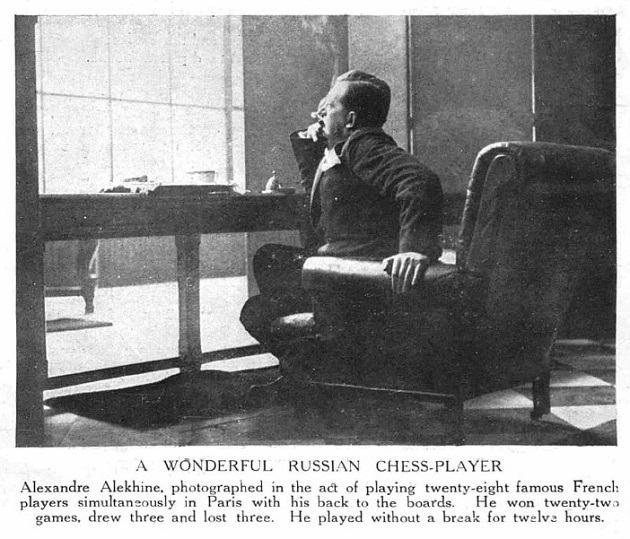
7 February 1925, page 191

15 October 1927, page 92
A slightly different version of this photograph exists, and page 202 of A History of Chess by Harry Golombek (London, 1976) had another shot, taken from the opposite direction and showing a cameraman.
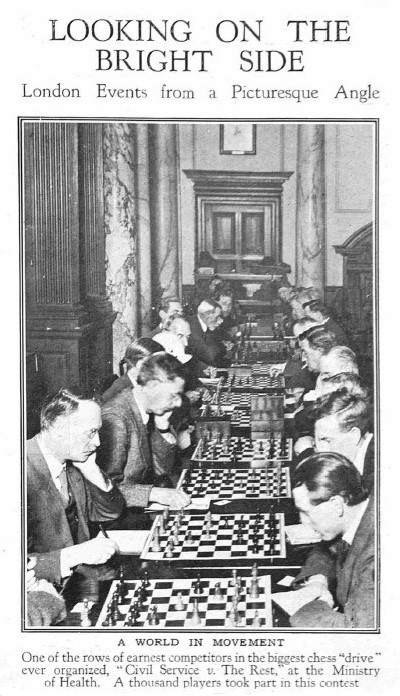
29 October 1927, page 187
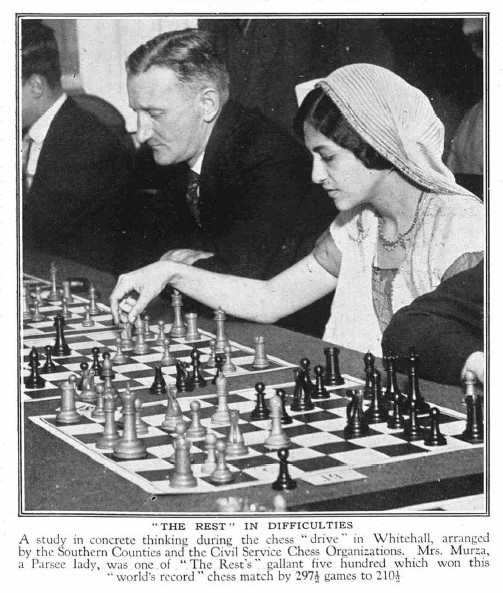
29 October 1927, page 187
From page 408 of the October 1927 BCM:
‘The Largest Chess Match of all Time. On Saturday, 22 October an attempt will be made to break all records as regards numbers by playing a match of 500 aside – 1,000 in all – between the Civil Service and the Rest of London. Some of the fine rooms at the Ministry of Health have been secured, and a most interesting contest should result. It is surprising what a large number of the strong players of London are Civil Servants; we understand the CSSA has over 1,100 members to choose from.’
The result was reported on page 496 of the December 1927 BCM:
‘In the Record Number chess match Civil Service v The Rest, played at the Ministry of Health on 22 October, 1,016 players actually took part, and the Civil Service did extremely well to only lose by three to two on the average. At the 24 top boards the Service led by 14 to 10; the majority of the leading players of London took part on one side or the other.’
Regarding the second photograph above, Mrs Marza/Murza was referred to in C.N. 7314.
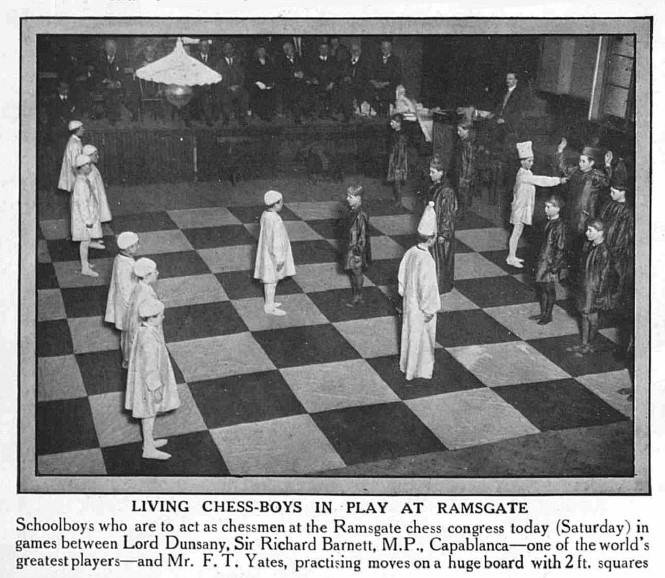
30 March 1929, page 490
See C.N. 4092.
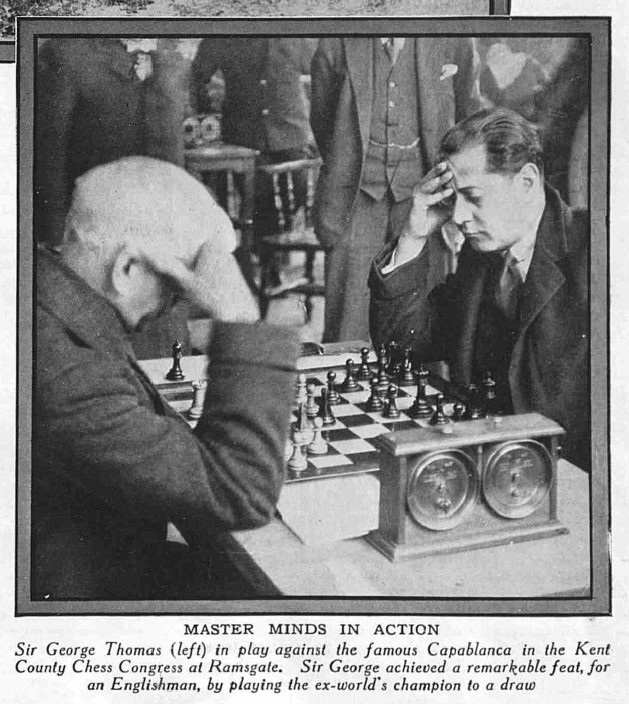
13 April 1929, page 63
A different version of this photograph was shown in C.N. 9021.
10303. Getty Images
The Getty Images website has many chess-related photographs, and Mr Urcan mentions that, for instance, the results of a search with the words ‘British Chess Championship’ include the following:

10304. Torre and Amaro
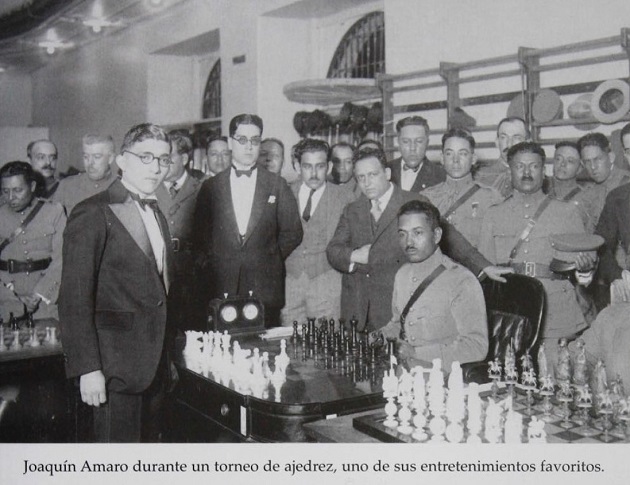
This photograph has been sent to us by Doug Geib (Brecksville, OH, USA), who obtained it when he acquired the chess set, table and clock in front of which Carlos Torre is standing. Joaquín Amaro Domínguez was a leading Mexican military figure. Information is sought concerning the simultaneous display in question.
10305. Botvinnik book
From page 8 of issue one of Albrecht Buschke’s publication Chess News from Russia, 10 November 1945:
‘Shortly before Dr Lasker’s death, i.e. almost three years after the return match between Alekhine and Euwe, the first few copies of a booklet about this match had arrived from Russia. The writer happened to have a copy of this booklet in his hands when he paid Dr Lasker one of his periodical visits. Dr Lasker had hardly looked at the book when he asked the writer emphatically to leave the book with him. At the astonished question whether he, of all chessplayers, had not seen these games yet, after almost three years, the Grand Old Man of Chess had a good and valid explanation: “Oh, I know the games, of course ... they don’t interest me any longer ... what I want to study are Botvinnik’s notes to these games – they are of real importance ...”’ (Ellipses in the original.)
Botvinnik’s volume on the 1937 Euwe-Alekhine match was reprinted by Издательство “Галерия”, Moscow in 2002:

10306. Attacking the base of a piece chain
This undated contest between M. Sokoler and M. Bock was annotated in John W. Collins’ ‘Postal Games’ column on page 378 of the December 1956 Chess Review:
1 d4 d5 2 c4 dxc4 3 Nf3 a6 4 e3 b5 5 a4 Bb7 6 b3 cxb3 7 axb5 axb5 8 Bxb5+ Nd7 9 Rxa8 Bxa8 10 Ne5 Nf6 11 Qxb3 e6 12 O-O Bd6 13 Qa4 Bb7 14 Nc3 Qe7 15 Bc6 Bc8 16 Nb5 O-O 17 Nxd6 cxd6 18 Ba3 Rd8 19 Qa7 Re8 20 Nc4 Nf8 21 Qxe7 Rxe7 22 Bxd6 Ra7 23 Rb1 Ra2 24 g3 N8d7 25 Na3 h6 26 Bb5 Ne4 27 Bc4 Rd2
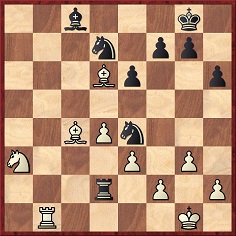
28 Bb4 Rxf2 29 Bd3 Ndf6
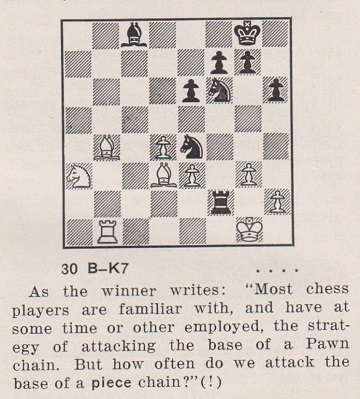
After 30 Be7 the game ended 30...Rd2 31 Bxe4 Nxe4 32 Rb8 Rd1+ 33 Kg2 Rc1 34 Bc5 Resigns.
10307. The Illustrated Sporting and Dramatic News
Following on from C.N. 10291 (The Sphere) and C.N. 10302 (The Graphic), Olimpiu G. Urcan (Singapore) has provided a set of chess pictures published in the Illustrated Sporting and Dramatic News:
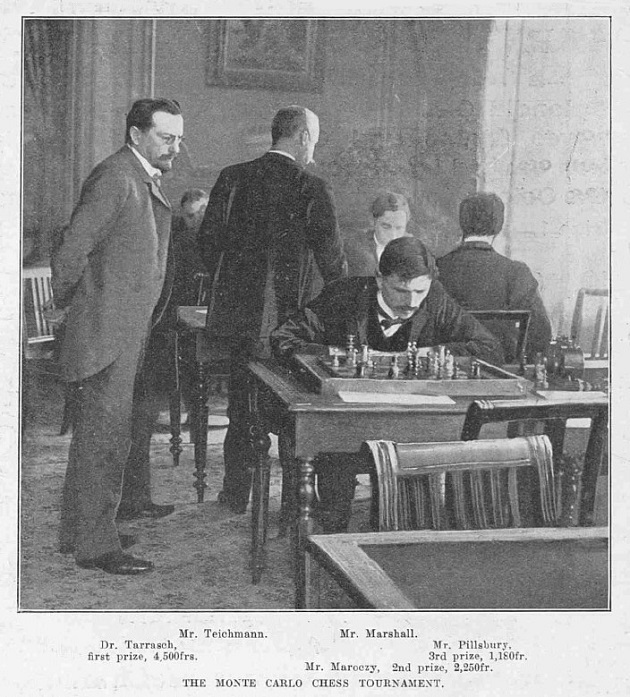
28 March 1903, page 136

26 August 1905, page 1008
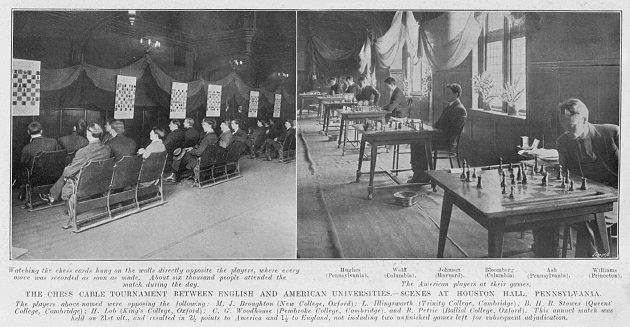
11 April 1908, page 205
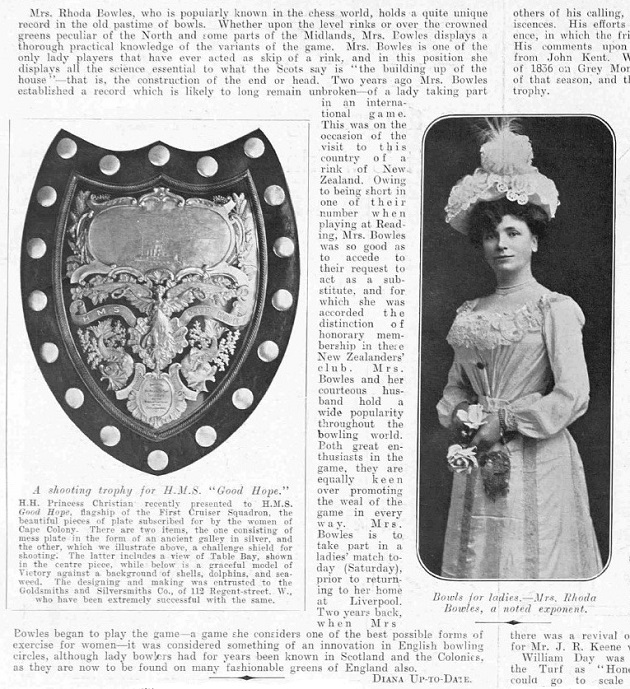
5 September 1908, page 32

16 January 1909, page 799
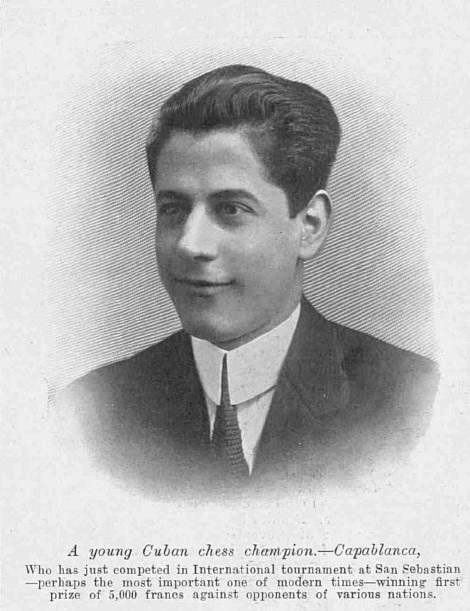
25 March 1911, page 137
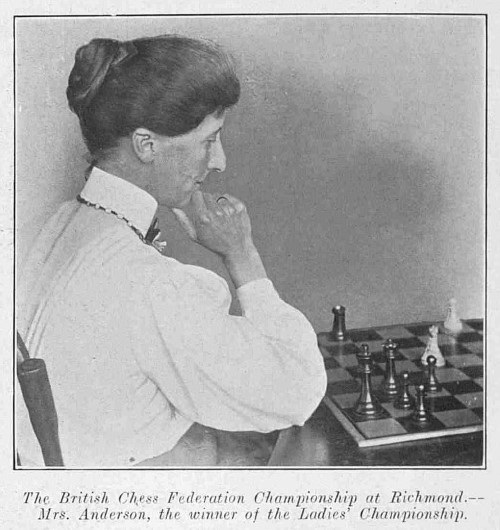
31 August 1912, page 1254

13 May 1916, page 291
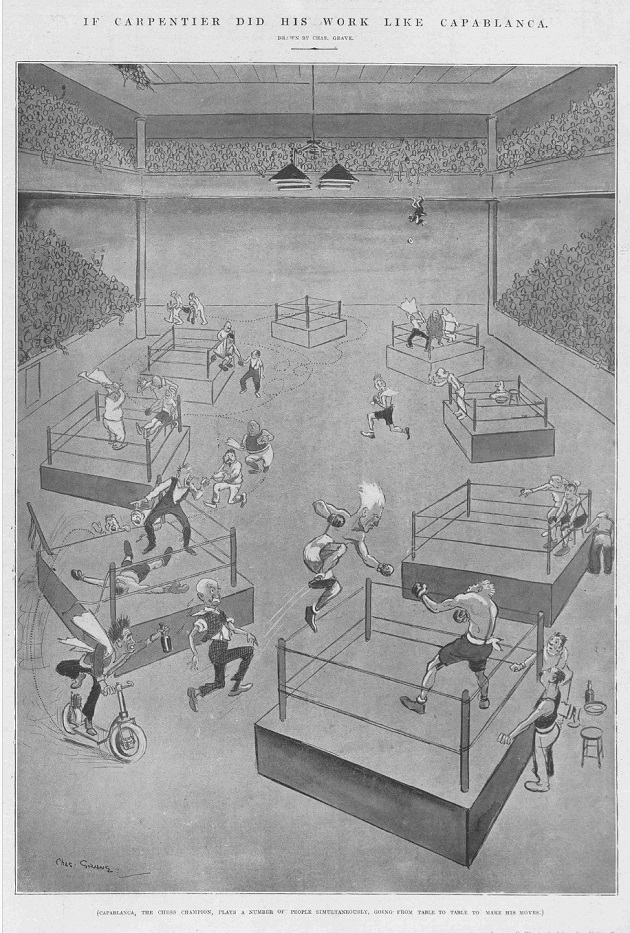
21 February 1920, page 871

22 October 1921, page 249
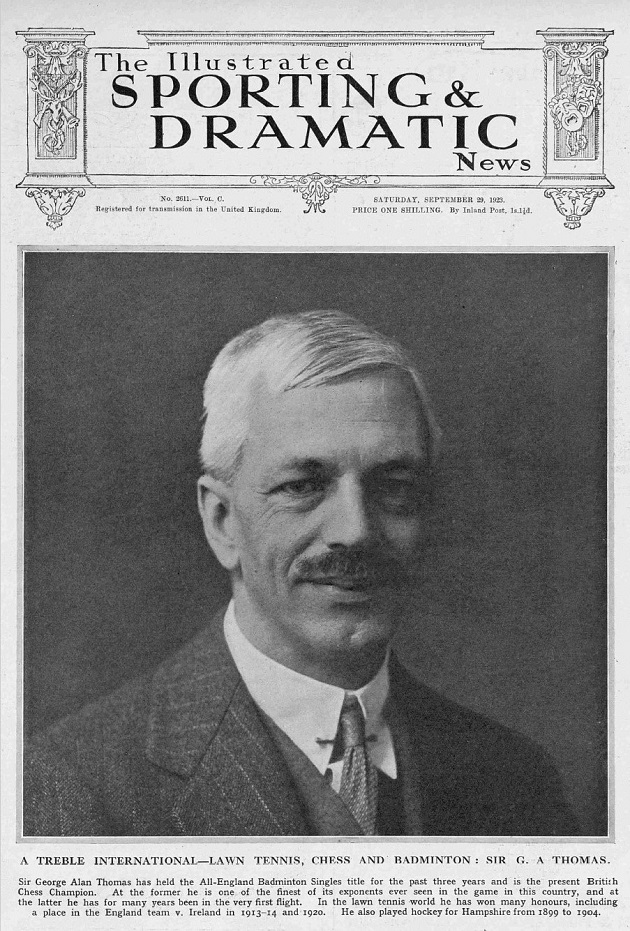
29 September 1923, page
683

22 January 1927, page 167
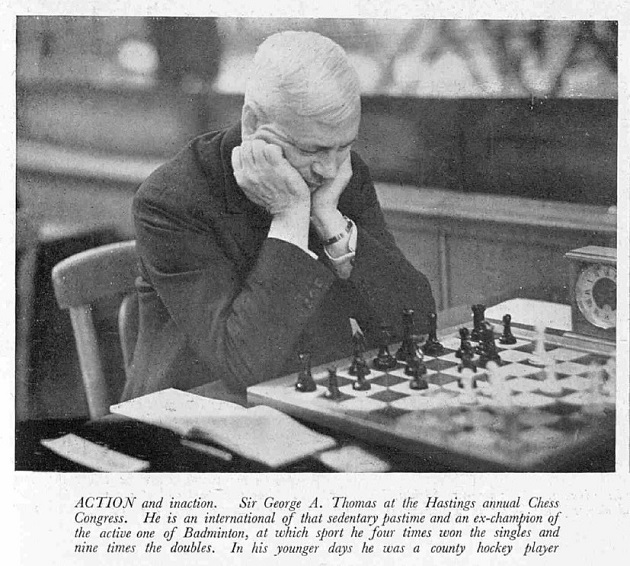
6 January 1934, page 41

13 January 1934, page 64.
10308. Capablanca v Ribera (C.N. 10296)
Juan Carlos Sanz Menéndez (Alcorcón, Spain) notes the coverage on pages 1982-1984 and 1993-1994 of Els Escacs a Catalunya, January-February 1936 and, in particular, the fact that on page 1994 the score of Capablanca v Ribera had 19...Nf5, and not 19...Qe8:
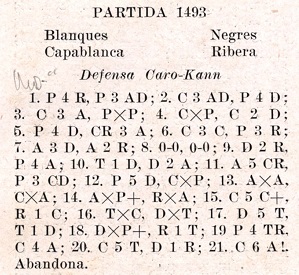
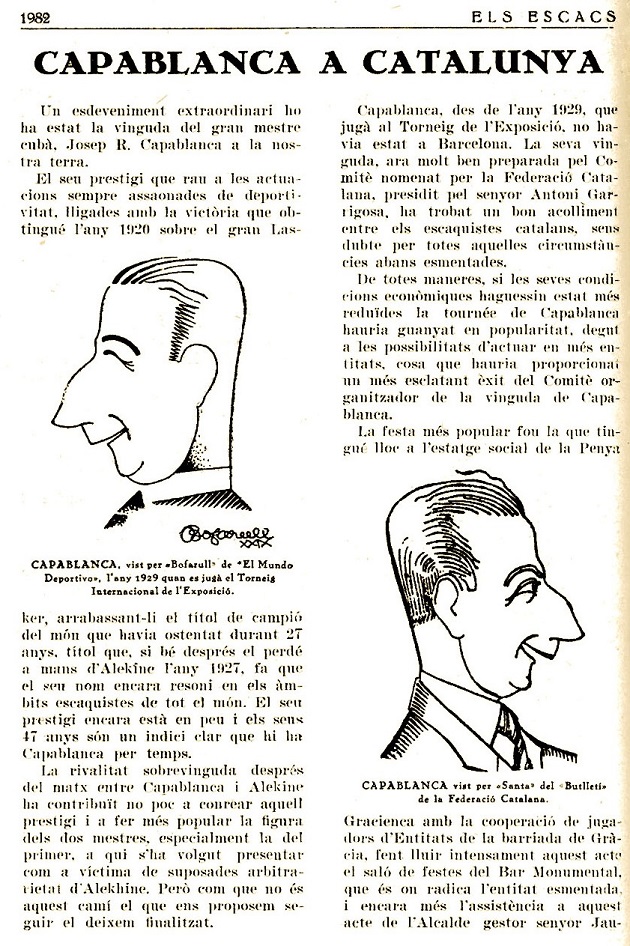
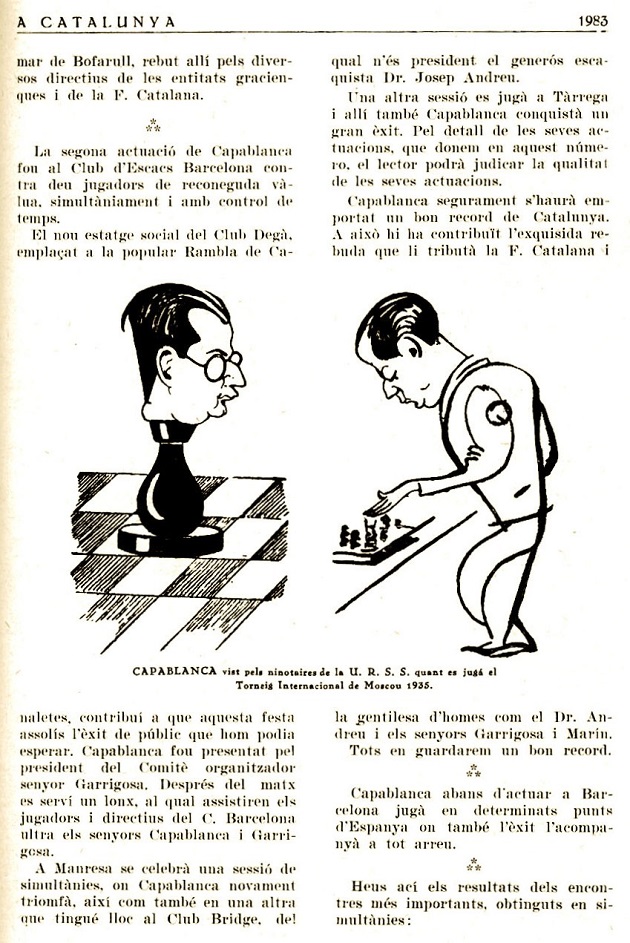
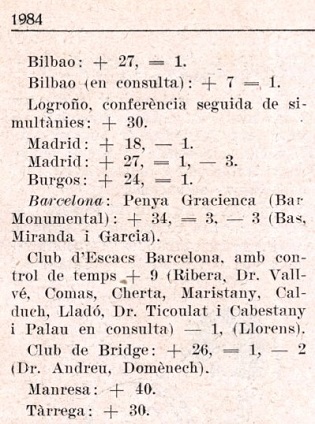
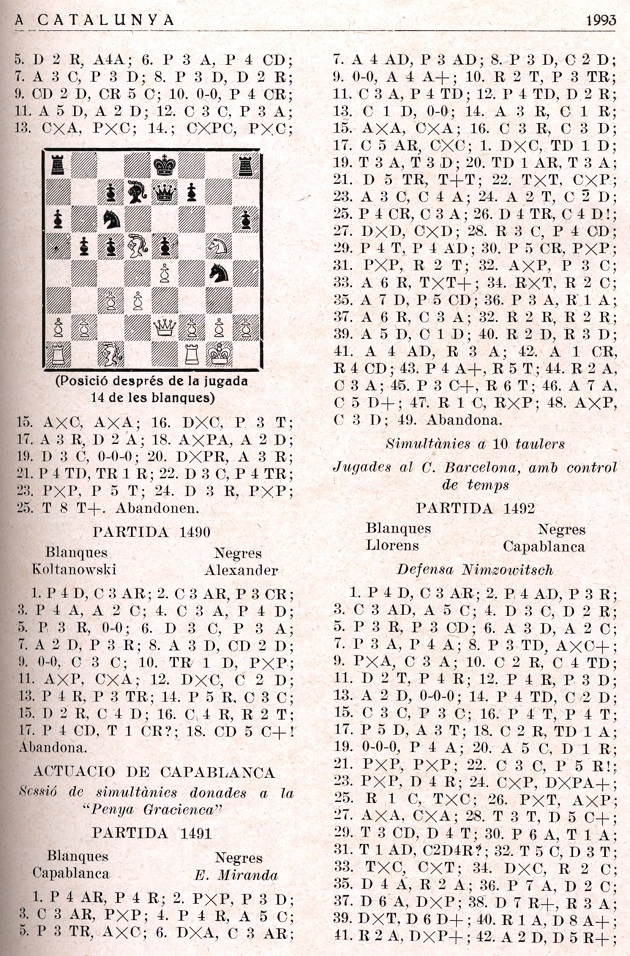
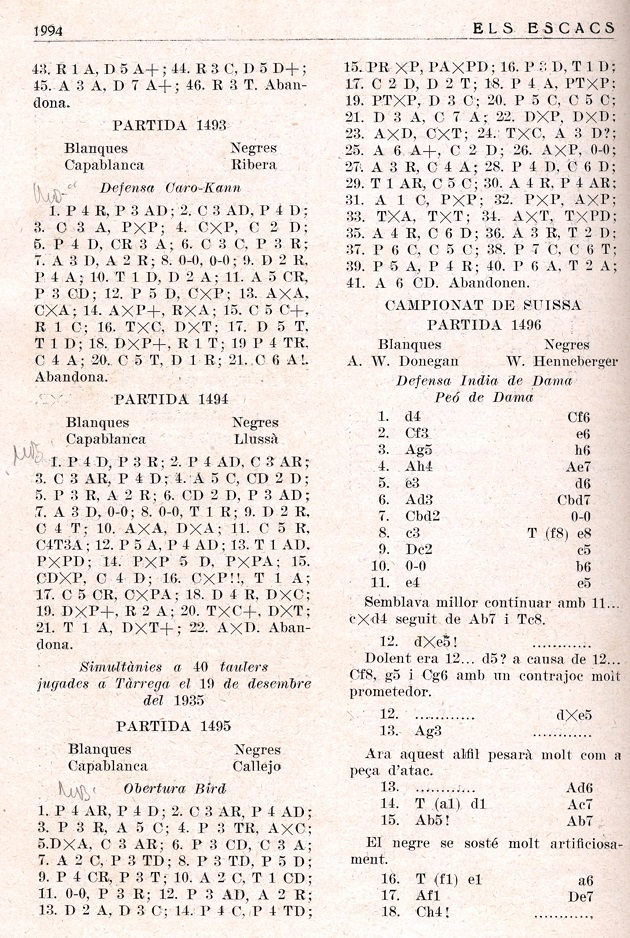
Our correspondent also points out an article about Ángel Ribera Arnal by Joaquim Travesset, as well as a column by Ramón Rey Ardid on page 14 of La Vanguardia, 20 December 1935 which confirms that the ten-game simultaneous display with clocks in Barcelona was on 14 December 1935.
10309. Budapest, 1921
From Jan Kalendovský (Brno, Czech Republic) come photographs of Alekhine, Tartakower, Vajda and Grünfeld published on page 4 of Das interessante Blatt, 6 October 1921:
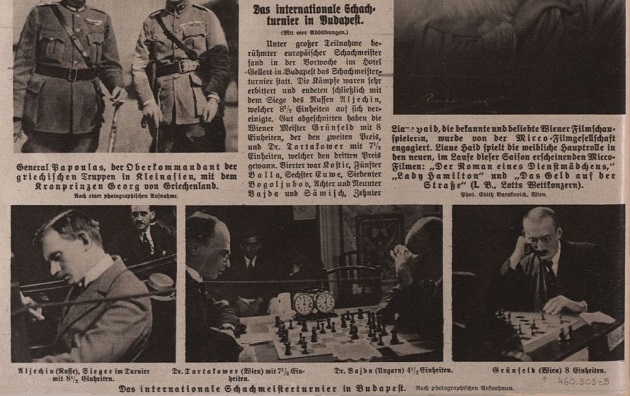
10310. Fischer in Reykjavik
From Sean Robinson (Tacoma, WA, USA):
‘Section 3 of your feature article on the 1972 Reykjavik match refers to Kavalek’s role as a second, and his correspondence with you includes an important detail:
“To my knowledge, there were only three other people (Bill Lombardy, Fred Cramer and Brad Darrach) who had daily contact with Fischer away from the playing hall.”
Your article adds this excerpt from Kavalek’s article in the 6/2012 issue of New in Chess:
“It was during this game [the 13th] that I started working with Bobby on the adjournment games after he sent his official second, Bill Lombardy, away from his suite. Bobby and Bill were a great pair, but during that night they turned into two strong personalities with two different opinions. The tension was resolved by Lombardy’s sneeze. ‘I don’t want to get your cold, Bill’, Bobby said and added he wanted to work with me. Bill left quietly.
From that moment on, I analysed just with Bobby till the end of the match.”
Compare that account with Darrach’s gossipy version on pages 219-220 of Bobby Fischer vs. the Rest of the World:
“Bobby meanwhile was having a personnel problem. After six weeks of trying to pull as a team, Bobby and Lombardy had developed halter sores. During dinner, Lombardy sneezed a few times; Bobby made a five-act drama of the incident. ‘You got a cold, Bill! You know I can’t afford to catch a cold now!’ Half an hour later, when Lombardy arrived in Bobby’s suite to resume analysis, he found grandmaster Lubomir Kavalek across the board from Bobby.
‘Bill, you go analyze somewhere else’, Bobby said carelessly. ‘I want to work with Lubosh.’ As Lombardy left, Bobby sat looking after him. ‘You know’, he said, ‘I think Bill is a vicious person.’
Though only the inner circle was aware of it, Bobby worked with Kavalek from the 13th game forward more than he worked with Lombardy.”
Lombardy alludes to the situation on pages 219-220 of Understanding Chess (Milford, 2011):
“Suffice to say, I was the only person on the intimate inside during that Match of the Century. I chose to say very little because I do not delight in satisfying idle curiosity! As for my ‘uselessness’ on the technical side of chess at Reykjavik, let me point out that there were 14 adjourned games. Bobby and I worked together on those adjourned positions without making a single technical error! Beyond that, I bested the Soviet team psychology, even though that team had a so-called professional psychologist. For little remuneration, I dedicated my services in the Icelandic capital to guarantee that Bobby followed through and finished the match victoriously.”’
10311. Fisher v Roberts
Gerard Killoran (Ilkley, England) sends this game involving John Drew Roberts, from page 463 of the Illustrated London News, 8 May 1880:
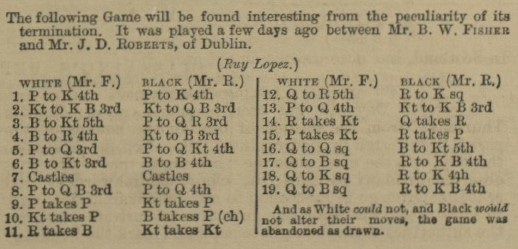
1 e4 e5 2 Nf3 Nc6 3 Bb5 a6 4 Ba4 Nf6 5 d3 b5 6 Bb3 Bc5 7 O-O O-O 8 c3 d5 9 exd5 Nxd5 10 Nxe5
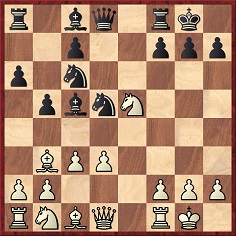
10...Bxf2+ 11 Rxf2 Nxe5 12 Qh5 Re8 13 d4 Nf6 14 Rxf6 Qxf6 15 dxe5 Rxe5 16 Qd1 Bg4 17 Qf1 Rf5 18 Qe1 Re5 19 Qf1 Rf5 Drawn.
10312. General Eurico Gaspar Dutra
A photograph of the Brazilian President in play against Gilberto Câmara, from page 8 of Chess Review, January 1950:
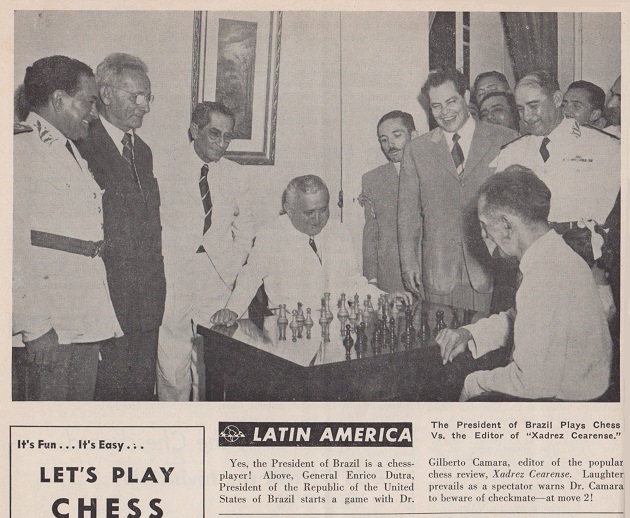
10313. Beatrice Wood and Marcel Duchamp
Further to C.N. 7192 (see too The Chess Opening 1 h4), Harrie Grondijs (Maastricht, the Netherlands) writes:
‘Page 14 of the catalogue of a 1983 exhibition of works by Beatrice Wood (1893-1998) has a 1917 drawing of Marcel Duchamp playing chess with Francis Picabia:
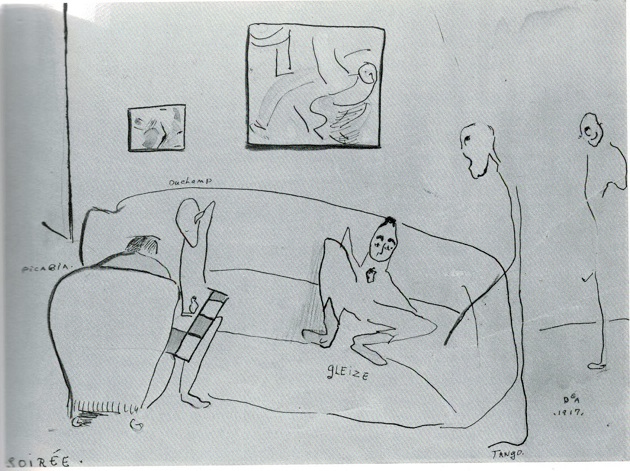
The accompanying text on page 14:
“Wood’s many drawings from this period provide us with the most complete and succinct visual record of the New York DADA group. In a drawing entitled Soirée of 1917 (fig. 8) we find Duchamp and Picabia intently engaged in a game of chess, while further down on the couch the French Cubist painter Albert Gleizes is sprawled out, staring obliviously into space. A fourth man labeled Tango appears to observe the progress of the chess match, while a fifth unidentified figure lurks mysteriously in the background.”
The catalogue also has, on page 23, a photograph of Duchamp, Picabia and Wood (Coney Island, 21 June 1917).’

10314. 1 h4
From page 239 of My Seven Chess Prodigies by John W. Collins (New York, 1974):
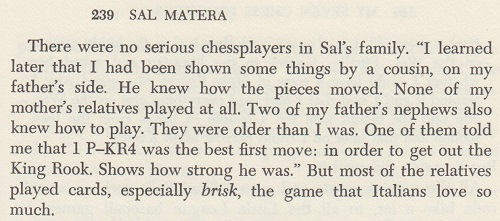
10315. A poem by A.C. White
On the subject of Chess and Poetry, Michael McDowell (Westcliff-on-sea, England) sends a poem by A.C. White published on page 81 of Memories of My Chessboard (Stroud, 1909):
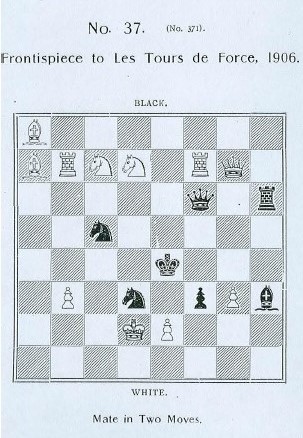
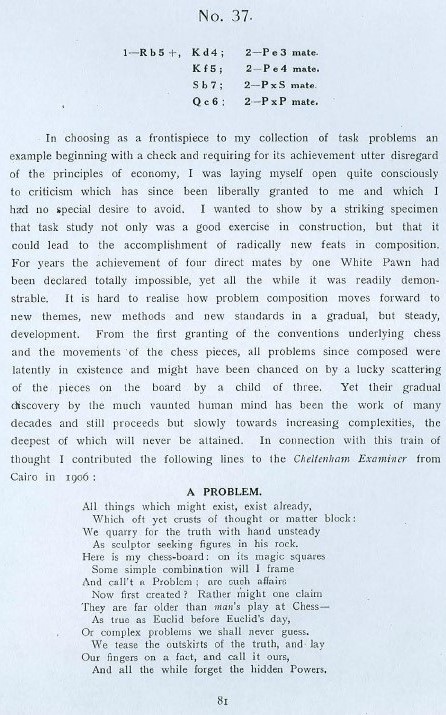
As shown below, the poem had been reproduced from the Cheltenham Examiner on page 8 of the Falkirk Herald, 21 March 1906:
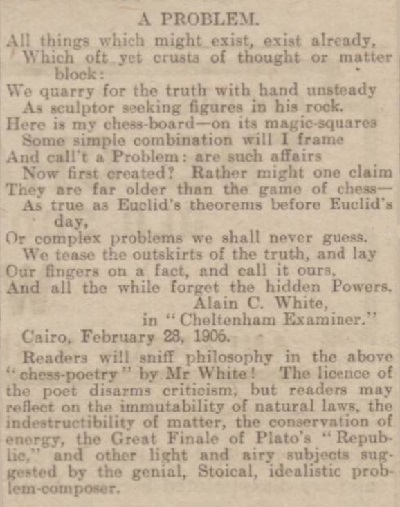
It was also published on page 177 of the April 1906 BCM.
10316. Znosko-Borovsky and Capablanca
C.N.s 2032 and 9843 (see Chess Anecdotes) discussed a groundless old yarn about Znosko-Borovsky and Capablanca. Some further citations:
- ‘When the Russian Master, Eugene Alexandrovich Znosko-Borovsky, published a booklet entitled Capablanca’s Mistakes, Capa was not slow to announce that he had tried to write a book called Znosko-Borovsky’s Good Moves, but had renounced the project in despair at the lack of material.
Of Capablanca’s own games it has been written, with justice, that they breathe a serenity, a lucid crystal clarity, a type of model perfection. Indeed, that they are the product of supreme chessboard art.’
Raymond Keene, on page 40 of The Times (Review Section), 19 November 1988;
- ‘When the Russian master, Eugene Alexandrovich Znosko-Borovsky, published a booklet entitled Capablanca’s Mistakes, Capa was not slow to announce that he had tried to write a book called Znosko-Borovsky’s Good Moves, but had renounced the project in despair at the lack of material.
Of Capablanca’s own games it has been written, with justice, that they breathe a serenity, a lucid crystal clarity, a type of model perfection. Indeed, that they are the product of supreme chessboard art.’
Raymond Keene, on page 236 of Keene On Chess (New York, 1999);
- ‘When the Russian master, Eugene Alexandrovich Znosko-Borovsky, published a booklet entitled Capablanca’s Mistakes, Capa was not slow to announce that he had tried to write a book called Znosko-Borovsky’s Good Moves, but had renounced the project in despair at the lack of material.
Of Capablanca’s own games it has been written, with justice, that they breathe a serenity, a lucid crystal clarity, a type of model perfection. Indeed, that they are the product of supreme chessboard art.’
Raymond Keene, on page 237 of Complete Book of Beginning Chess (New York, 2003);
- ‘When the Russian chess master, Eugène Znosko-Borovsky, published a booklet entitled Capablanca’s Mistakes, Capa was not slow to announce that he had tried to write a book called Znosko-Borovsky’s Good Moves, but had renounced the project in despair at the lack of material.
Of Capablanca’s own games it has been written, with justice, that they breathe a serenity, a lucid crystal clarity, a type of model perfection. Indeed, that they are the product of supreme chessboard art.’
Raymond Keene, on pages 40-41 of World Chess Championship Kramnik vs. Leko (Aylesbeare, 2004);
- ‘When the Russian chess master, Eugène Znosko-Borovsky, published a booklet entitled Capablanca’s Mistakes, Capa was not slow to announce that he had tried to write a book called Znosko-Borovsky’s Good Moves, but had renounced the project in despair at the lack of material.
Of Capablanca’s own games it has been written, with justice, that they breathe a serenity, a lucid crystal clarity, a type of model perfection. Indeed, that they are the product of supreme chessboard art.’
Raymond Keene, on page 34 of Vishy’s Victory (2007);
- ‘When the Russian chess master, Eugène Alexandrovich Znosko-Borovsky, published a booklet entitled Capablanca’s Mistakes, Capa was not slow to announce that he had tried to write a book called Znosko-Borovsky’s Good Moves, but had renounced the project in despair at the lack of material.
Of Capablanca’s own games it has been written, with justice, that they breathe a serenity, a lucid crystal clarity, a type of model perfection. Indeed, that they are the product of supreme chessboard art.’
Raymond Keene, on page 21 of Battle of Bonn (2008);
- ‘When the Russian master, Eugene Alexandrovich Znosko-Borovsky, published a booklet entitled Capablanca’s Mistakes, Capa was not slow to announce that he had tried to write a book called Znosko-Borovsky’s Good Moves, but had renounced the project in despair at the lack of material.
Of Capablanca’s own games it has been written, with justice, that they breathe a serenity, a lucid crystal clarity, a type of model perfection. Indeed, that they are the product of supreme chessboard art.’
Raymond Keene, on page 58 of Carlsen-Anand Match for the World Chess Championship (Bronx, 2013).
As regards the second paragraph in each of those seven passages, the uncredited writer of the ‘lucid crystal clarity’ remark was Harry Golombek, on page ix of Capablanca’s Hundred Best Games of Chess.
10317. Article by Esther Singleton
Eduardo Bauzá Mercére (New York, NY, USA) has provided an article by Esther Singleton on page 27 of the Philadelphia Inquirer, 14 July 1895:
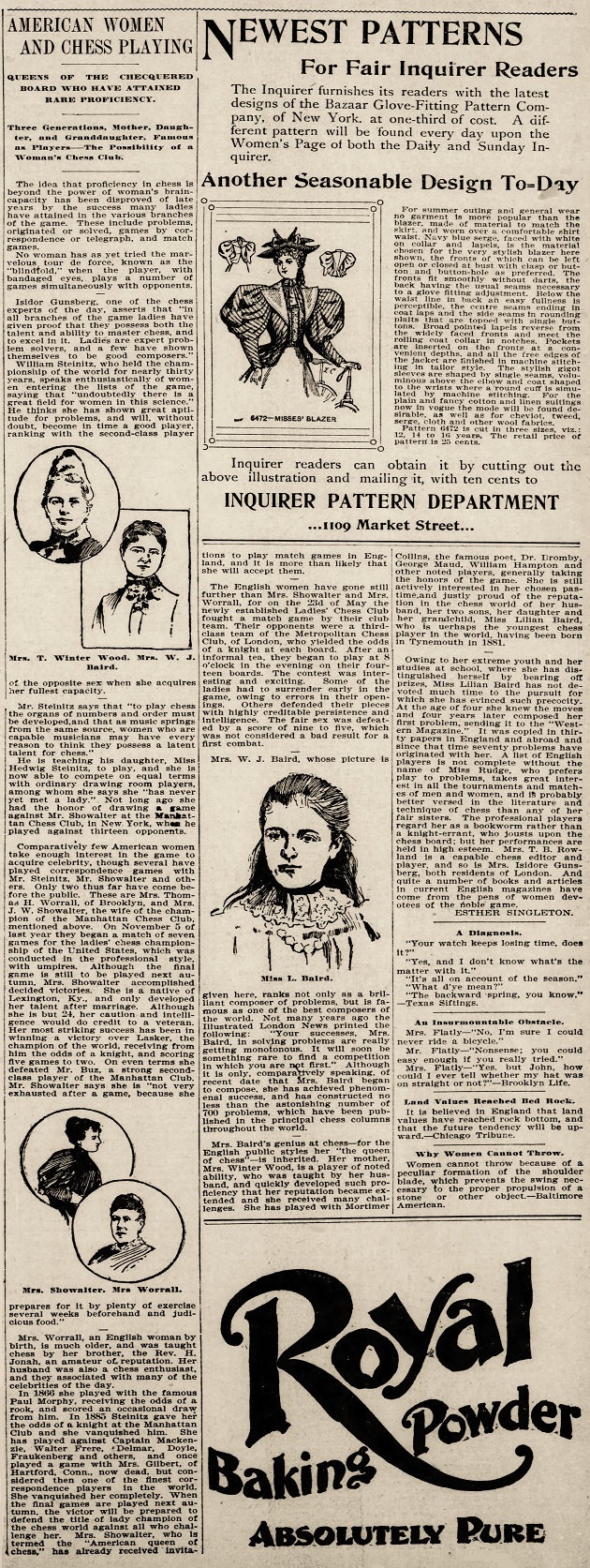
10318. Rubinstein and Norman
From pages 20-21 of The Bright Side of Chess by Irving Chernev (Philadelphia, 1948):

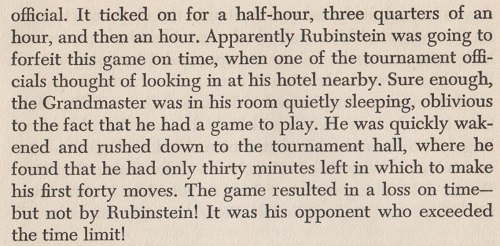
This story was examined critically in C.N.s 3092 and 3095 (see page 107 of Chess Facts and Fables and Chess Anecdotes), and now Gerard Killoran (Ilkley, England) draws attention to Norman’s own account, in a chess column by Frank Rhoden on page 10 of the Hastings & St Leonards Observer, 20 April 1957:

10319. Two old stories
B.H. Wood’s column in the Illustrated London News, 24 September 1955, page 540:

The article, which was reproduced on page 14 of the January 1956 Chess Review, is relevant to two feature articles, A Chess Hoax and The Cambridge v Bedlam Chess Story.
A remark by Wood in his Illustrated London News article deserves to be highlighted:
‘More silly things are written about chess than about any other game I know.’
10320. B.H. Wood and his daughter
From page 443 of the Sketch, 7 May 1952:
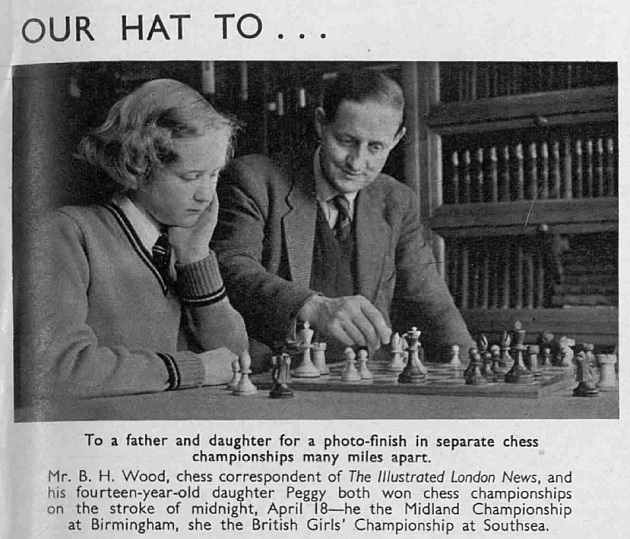
The events were reported on page 151 of CHESS, May 1952:
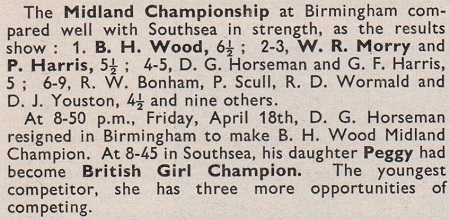
10321. Jacob Bernstein
Nechemia Kasimov (Toronto, Canada) has sent us a report published on page 4 of the Lithuanian newspaper Lietuvos žinios, 1 May 1923 which stated, in connection with two visits, that Jacob Bernstein was a native of Kaunas, Lithuania:
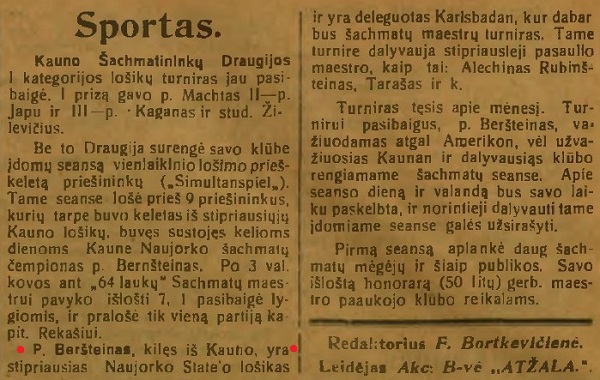
The report also referred to Bernstein’s participation in Carlsbad, 1923 (which, it may be noted, was held from 27 April to 22 May).
10322. The Nimzowitsch threat/execution story
From page 65 of Il lessico degli scacchi by Yuri Garrett (Brescia, 2012):

Any assumption that the footnote is the result of original research by Mr Garrett will be dispelled by scrutiny of our feature article A Nimzowitsch Story. He can, though, take responsibility for ‘Adolf’ (instead of Alfred) Brinckmann, as well as for ‘Jaques’ (instead of Jacques) Mieses.
Mieses’ reminiscences about Nimzowitsch did not assert that the smoking incident occurred at Bled, 1931, and the footnote in Il lessico degli scacchi provides another example of the perils of blind copying. The reference ‘Hannak 1975: 10’ concerns a 1970s Italian translation of Nimzowitsch’s Mein System which contained, on pages 5-33, an introductory essay by J. Hannak entitled ‘Vita di un pessimista’. From page 10 of that book, Il mio sistema:
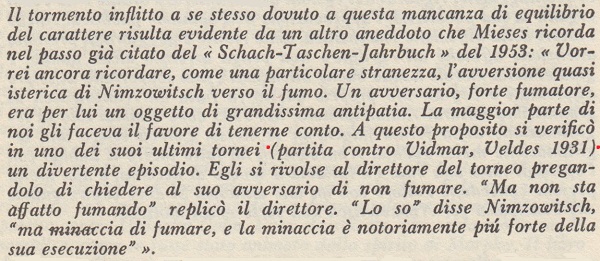
It is indeed indicated that Mieses’ article in the Schach-Taschen-Jahrbuch 1953 stated that the smoking incident occurred in a game between Nimzowitsch and Vidmar at Bled, 1931, but Hannak’s original German text, ‘Lebenslauf eines Pessimisten’ in Mein System (Berlin-Frohnau, 1958), shows that the mention of Bled, 1931 was not by Mieses but was an editorial addition by Hannak himself. From page 13:
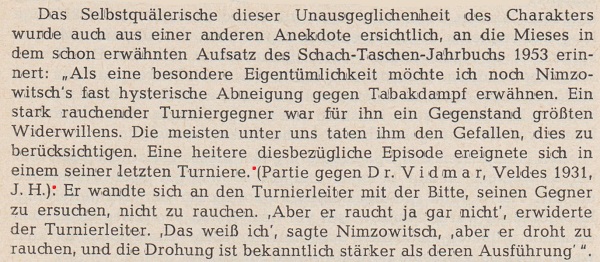
Below, courtesy of the Cleveland Public Library, is the relevant passage from Mieses’ article, ‘Erinnerungen an Nimzowitsch’, on page 43 of Schach-Taschen-Jahrbuch 1953:
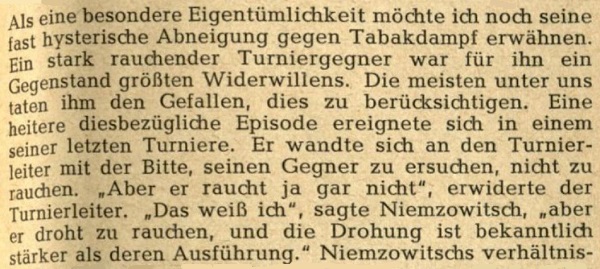
The heading on page 37:

Nor, naturally enough, was there any mention of Bled, 1931 in an earlier, very similar, article by Mieses, ‘Recollections of A. Nimzowitsch’, on pages 241-244 of the August 1947 BCM. From page 244:

The question now is why Hannak specified that the smoking incident occurred during one of the Nimzowitsch v Vidmar games (two short draws) at Bled, 1931.
10323. Carl F. Jaenisch
Bruce Leverett (Pittsburgh, PA, USA) notes that a number of websites give one of Jaenisch’s forenames as Ferdinand, as opposed to Friedrich (the latter being found in most chess reference books).
Almost everything in Jaenisch’s name seems debatable, including the spelling of his surname (citations can be provided for Jaenisch, Jänisch, de Jaenisch and de Jænisch), but the most interesting point is Mr Leverett’s: recent advocacy of ‘Carl Ferdinand’ Jaenisch/‘Карл Фердинанд’ Яниш. Has the Friedrich-Ferdinand discrepancy already been researched authoritatively or, indeed, resolved?
10324. Edward Lasker and Claude E. Shannon
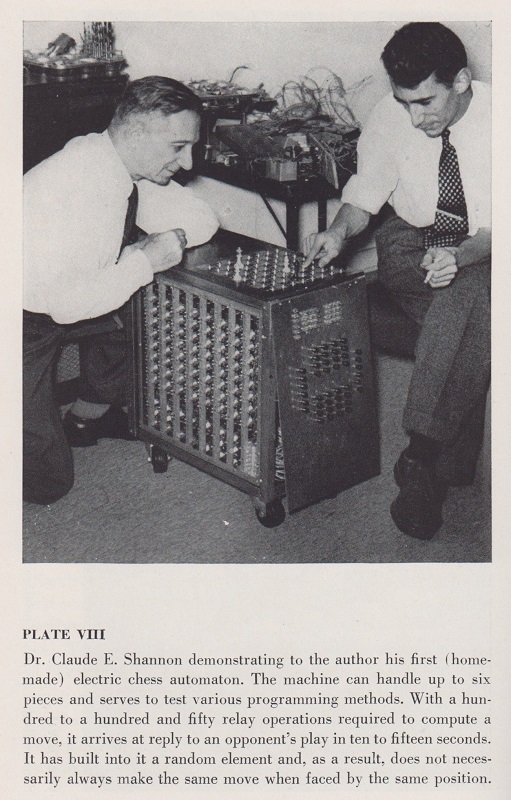
The Adventure of Chess by Edward Lasker (New York, 1950), opposite page 201

Chess Review, January 1951, page 13.
10325. 6x6 chess
An article ‘Experiments in Chess on Electronic Computing Machines’ by P. Stein and S. Ulam on pages 13-16 of the January 1957 Chess Review was introduced by Edward Lasker and ended with three games of ‘6x6 chess’. For example:
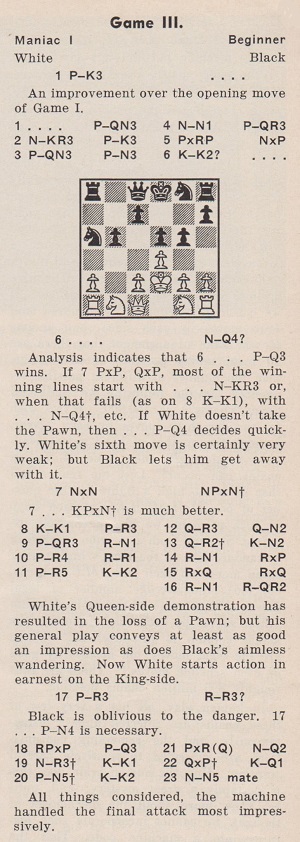
The three games, together with a summary of the rules, were published in the entry on Los Alamos Chess on pages 175-176 of The Encyclopedia of Chess Variants by D.B. Pritchard (Godalming, 1994).
10326. Bernstein v Maróczy, Ostend, 1906 (C.N. 10300)
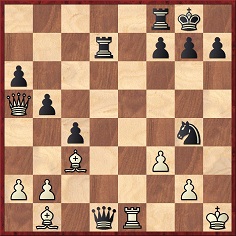
Position after 26 f3
From Peter Anderberg (Harmstorf, Germany):
‘According to W.A. Földeák in the 18/1967 issue of Schach-Echo, pages 285-286, Maróczy refrained from playing 26...Re8 because H. Wolf, who was standing in the crowd of onlookers, had audibly but inadvertently mentioned the possibility of that winning move.’
On pages 284-286 Schach-Echo gave the full game with Maróczy’s annotations translated from Hungarian into German. Below is the conclusion and Földeák’s afterword.
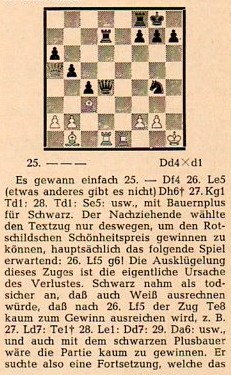

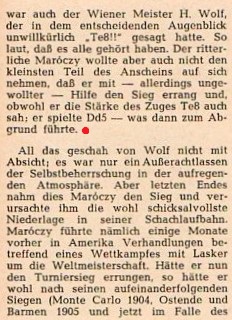

| First column | << previous | Archives [150] | next >> | Current column |
Copyright: Edward Winter. All rights reserved.
